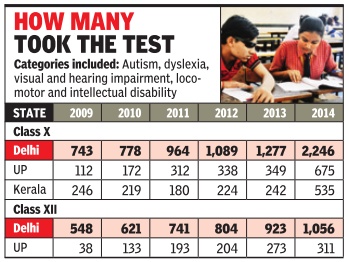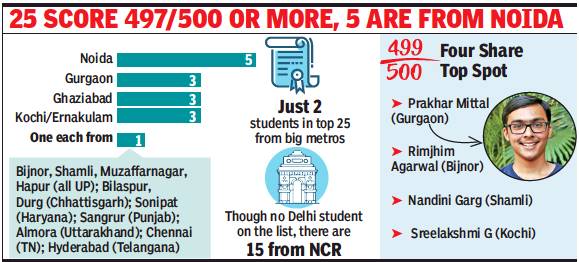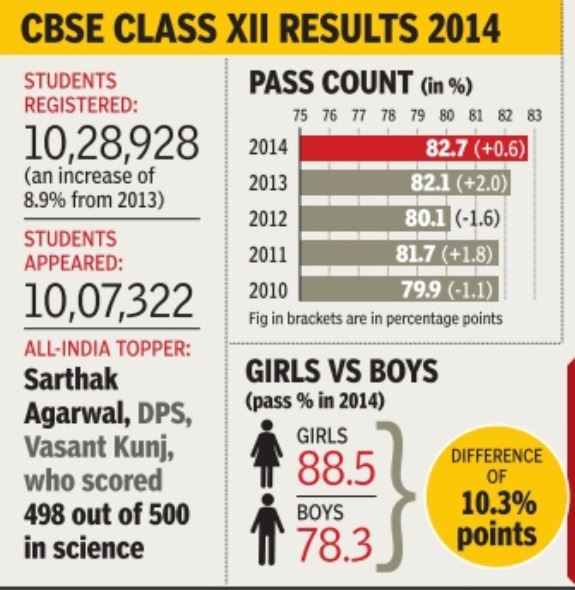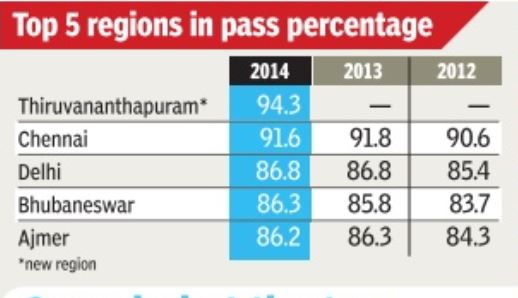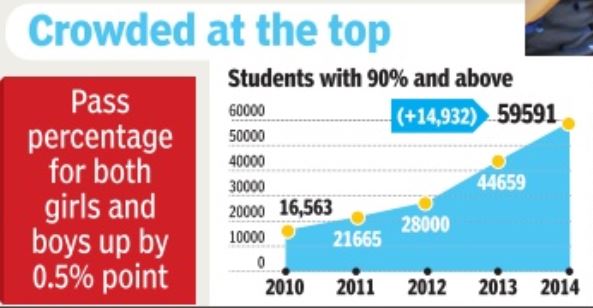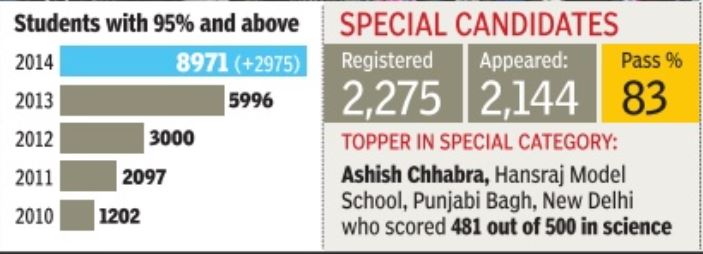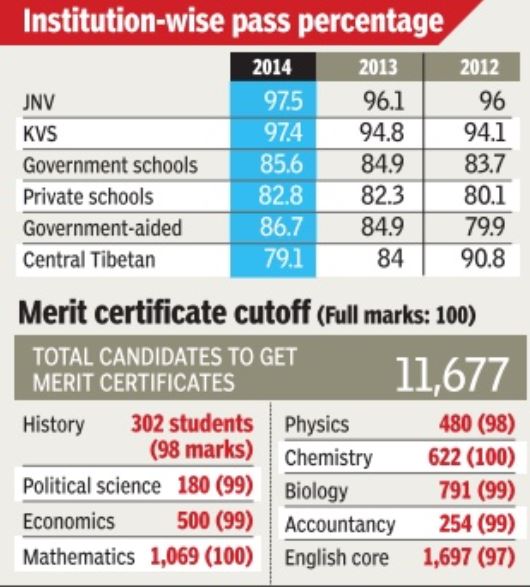Central Board of Secondary Education (CBSE)
This is a collection of articles archived for the excellence of their
content. You can update or correct this page, and/ or send graphs to the Facebook page, Indpaedia.com. All information used will be duly acknowledged. |
Affiliated schools
Growth: 1996-2013
No. of CBSE schools triple in 17 yrs
Hemali Chhapia Shah & Vinamrata Borwankar Mumbai:
TNN The Times of India Jun 18 2014
Almost half-a-dozen school boards—local, national and international—offer Indian students a choice of academic algorithms for careers ahead. The landscape of school education has for long promised a variety of options.
But of them all, CBSE (Central Board of Secondary Education), which was largely designed for those who moved home and could not be loyal to a state board, is picking up popularity across the nation.
In 1996-97, there were 4,843 affiliated schools to the CBSE board, which has grown to
15,000 institutes now, with most of the growth attributed to independent private schools, indicating the way the wind is blowing. While every year thousands of Indian parents find it tough to decide which board their child must sign up for, new school managements too face the same quandary when they start operations.
CBSE officials and school principals attribute the board’s popularity to its academic and administrative reforms which are student and school friendly. “Close to 98% of the schools that apply for affiliation are new institutes,” said an officer. Since 2005, the affiliation process is online and information at every stage is sent via electronic mail. “Also, the board is a national board, allowing parents to shift to just about anywhere in the country. The NCERT syllabus is also the most modern and wholesome one which is in tune with the times,” said a
CBSE administrative officer.
Little wonder then that in 2001-02 there were 6,293 affiliated schools, a number which increased to 13,898 in March 2012-13. Most of the growth came from independent institutes, the count of which went up from 3,483 in 2001-02 to 10,290 by the end of 2013.
Delhi has the largest number of CBSE schools, followed by UP, Haryana and Kerala.
Maharashtra, which has seen a 67% increase in the number of CBSE schools in the last three years, is home to over 500 institutes. “We have introduced and successfully implemented the continuous comprehensive evaluation system.
Norms for affiliated schools
Safety of school children
All school buses must now have speed governors dictating a limit of 40 km per hour, GPS and CCTV cameras, the Central Board of School Education (CBSE) directed in new guidelines for safety of school children issued.
Stating that the norms “should be scrupulously followed and complied with by all affiliated schools“, the board stated that the management and the head of the school will be held responsible for any lapse which could lead to disaffiliation.
The CBSE divided the guidelines into seven categories which include exterior and interior of the bus, manpower and facilities, permits, arrangements by school authorities and advisory to parents.
The CBSE in its circular stated that “the recent unfort unate instances reported in the media about callous approach by certain schools with respect to safety of children during transit to and from school have again agitated deep concern regarding the safety of schoolchildren. The time has come to make schools sensitive to this serious issue.“
On the buses' exterior, the Board said buses should be pa inted yellow with the school name prominently on both sides. `School bus' should be written prominently on the back and front of the vehicle and if it is a hired bus, “On school duty“ should be clearly written.
The board also stated that the driver's name, address, licence number, badge number and the telephone number of the school or bus owner and transport department's helpline numbers should be displayed at prominent places inside and outside the bus. In the buses' interiors, windows will have to be fitted with horizontal grills and mesh wire, and doors with reliable locks.
School authorities will also have to provide one mobile phone in each bus and ensure that the buses are not permitted to overtake any four-wheeler while carrying children.
Schools should tie-up with nearby hospitals
Piyush Sharm, CBSE directs schools to tie up with hospitals, October 9, 2017: The Times of India
In the aftermath of the murder of a Class II student at Ryan International School in Gurgaon on September 8, the Central Board of Secondary Education (CBSE) has issued an advisory to affiliated schools to have a tie-up with nearby hospitals to ensure timely treatment of students in case of any health emergency.
In the circular, issued by CBSE chairman R K Chaturvedi to schools on October 4, the board has advised that the con tact numbers of the hospital concerned should be prominently displayed on the school premises so that staff can easily contact the hospital in case of an emergency . CBSE schools are supposed to have medical facilities on campus, including a sick room unit where students can rest in case of minor illness. These units are equipped with first-aid kits and medicines and should have trained nurses in attendance.
The circular was earlier issued on October 18, 2010, by then board chairman Vineet Joshi. “After the incident at Ryan International, the board has re-issued the circular and advised schools to implement it without delay,“ said Ramanand Chauhan, city coordinator of CBSE Agra.
Non-NCERT books, uniforms: HC rejects CBSE stand
HC rejects CBSE stand on sale of non-NCERT books, March 2, 2018: The Times of India
The Delhi high court quashed a CBSE circular barring sale of non-NCERT books and uniforms in affiliated schools across the country.
The court rejected the stand of Central Board of Secondary Education that the sale of such items amounted to “commercialisation” of education and noted that availability of books, stationery items and uniforms in the school premises would only add to convenience of parents and students.
In a recent order Justice Rekha Palli quashed a circular dated April 19, 2017 issued by CBSE advising schools not to indulge in any commercial activity by way of selling of books, stationery, uniforms and school bags within the premises and to adhere to the provisions of affiliation bylaws of the board.
In its circular, CBSE had also asked schools to refrain from forcing parents to purchase books/uniforms from shops within school premises or from selected vendors only.
“The admitted case of the parties is that the aforesaid items in school shops would be available only to the students of the school and not to outsiders and, therefore, I see no element of commercialisation in sale of these essential items in the school shops,”
HC noted pointing out that sale of books and uniforms in the school shops without any coercion can’t be treated as “commercialisation”.
It added that availability of uniforms, non-NCERT reference books or even food items for sale only to the students of the school cannot be considered “commercialisation”.
The court said the decision of CBSE to prohibit sale of items, needed by students in the schools, merely on the assumption that the availability of these items in school shops could be misused as the students and parents could be forced to buy them only from these shops, appeared to be “wholly arbitrary and quite irrational”.
HC also quashed conditions in another circular dated December 18, 2017 prohibiting sale of non-NCERT books in the school shops and directed the CBSE to “take regulatory steps to ensure that the students and parents are not coerced in any manner to buy any items from these shops”.
Dealing with the question of commercialisation of education, Justice Palli said “the availability of books, both NCERT and non-NCERT, stationery items and uniforms on school premises would only add to the convenience of the parents and the students”.
The court said the use of the school buildings for the purposes of education would put a corresponding duty on the school management to ensure that the students are provided with all necessary facilities to help them pursue education in the school.
2018: Stds IX & XI: schools can register up to 45 students
October 14, 2018: The Times of India
Schools facing difficulty while registering students in classes IX and XI for the 2018-19 session are being asked to contact the regional offices of Central Board of Secondary Education (CBSE).
The Board has, as a temporary relief for this year, allowed the schools to register up to 45 students per section instead of 40 as per the rules. However, private schools will have to pay the penalty to be levied against the school for violation of the stipulated student to section ratio. Schools having students in excess of data entered by the school in the Online Affiliated School Information System (OASIS) are facing difficulty.
According to a CBSE official, “The Board has asked the schools to request the regional offices. But they have to give justification about the excess students for seeking permission for their registration. The online system will be opened for them and they can update (edit) the data in OASIS, but that must be supported by evidence...”
While the last date for registration without late fee is October 22 the schools can register till November 28with late fee. “If the schools have the infrastructure and space, they can add new sections and submit the details seeking permission for the additional section,” said the official.
Affiliation bye-laws, 2018
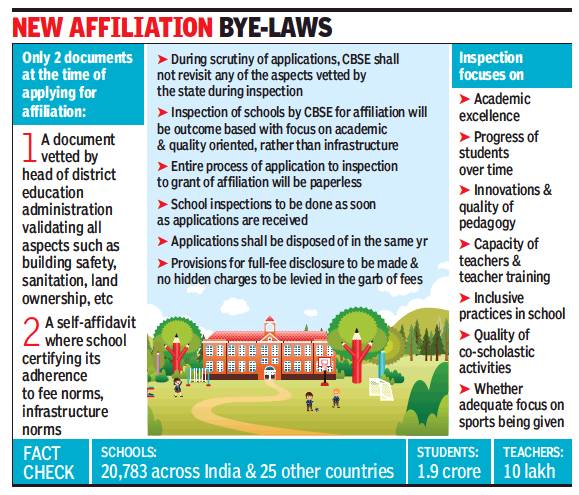
From: Manash Gohain, After revising bye-laws, CBSE clears 8,000 applications for affiliation, October 19, 2018: The Times of India
The Central Board of Secondary Education (CBSE) has cleared over 8,000 pending applications for affiliation, some dating as far back as 2007, after it revised bye-laws simplifying the process making it entirely paperless, reduced the requirement of documents from schools to just two and made it mandatory that all applications are disposed of in the same year.
The revised bye laws were released by the minister for human resource development, Prakash Javadekar on Thursday where he said that the focus is on a transparent and hassle-free process.
As first reported by TOI in July and August, 2018, affiliation bye laws, first made in 1988 and last amended in 2012, will focus on academic and co-scholastic qualities of the school. CBSE shall not revisit any of the aspects vetted by the state government during inspection of schools and the delay due to scrutiny and non-compliance of deficiencies in these documents shall be drastically curtailed during CBSE’s scrutiny of affiliation applications.
The bye laws also get more teeth like introduction of clause like exam malpractices in schools which could lead to punitive action like disaffiliation and more. The bye laws also include provisions for full-fee disclosure to be made and no hidden charges to be levied in the garb of fees.
Javadekar said that now assessments for affiliation will be more outcome based and CBSE will not duplicate the process of physical infrastructure and resource inspection as they are already done by the respective state governments while issuing recognition to the schools under the RTE Act.
“State education administration verifies various certificates to be obtained from local bodies, revenue department, cooperatives, etc. CBSE used to re-verify them which made the process lengthy. However, from now onwards the whole process will be online, transparent and will be done within a year. Also schools will need to submit just two documents. CBSE will not inspect schools for processes such as fire safety which were already done by the education department of the states,” said the minister.
The new affiliation byelaws also lay thrust on achieving academic excellence through mandatory teacher training. Even the principals and vice principals of every school are expected to undergo two-day mandatory training on annual basis. A special category of innovative schools has been added to include specialised schools, not covered elsewhere in these bye-laws, who are implementing innovative ideas in fields of skill development, sports, arts and sciences.
Conduct of examinations
How papers are marked
A CBSE examiner's candid account of how papers are marked, June 4, 2017: The Times of India
I'm an assistant head examiner, so our job is to make sure the examiners have marked scripts fairly, in accordance with the CBSE's marking scheme.
But I'm truly shocked by the vagaries of the system and quality of the examiners.We've had to ask a couple of them to go back. Examiners are picked by the CBSE, from schools, but many , especially those who teach in government schools, seem to be unequipped to grade. Some students don't end up getting the marks they deserve, while the rote learners do well.
Of course, it's a lot of pressure, you have to do ten scripts the first day, twenty the second day and so on, and maintain an average of about 25. You're very poorly paid -around 25 per paper for Class X and 30 per paper for Class XII -so most examiners simply don't want to do this work.
This one gentleman was being very stubborn and marking harshly. I had to correct upwards in all his scripts; he simply refused to get the point. Then we figured out that he is an accountancy teacher, not economics, and didn't understand that a student could answer a question correctly without sounding exactly like the CBSE's prescribed marking scheme.That is just a guideline, not a bible. For instance, a student can answer a question about the price elasticity of demand by a formula or by an example, one has to understand the approach. We had to ask him to leave, finally. We had to ask another lady to go back because she was just giving marks without reading. The other problem is that the CBSE often frames its marking schemes poorly . In one set of the economics exam, one question was wrong; it expected you to find 12 values but only 8 were calculable. Now imagine a student doing this, obviously they would fumble, possibly scratch out the earlier correct answers. In such a situation where the question is wrong, they should automatically give full marks to the student, but instead they said, give marks only if the first few have been correctly answered. This is unfair.The questions are supposed to be framed by literate people, how can they go wrong like this?
There's been a lot of talk about moderation, but we correct our scripts only by the marking scheme. There is no general moderation, at least up to our level. We are not supposed to check for passing or failing, or give any grace marks. But it's true that some subjects seem to produce incredible results, like getting a perfect 100 in English. In economics though, that doesn't happen much, in the 1100 scripts from our centre, not a single student got a 100.
The real problem is that we are dealing with examiners who are not always equipped to do their jobs, so we end up with some arbitrary and unfair results.There needs to be a minimum bar to become an examiner, one has to have taught the subject at the Plus-Two level for at least two years.But this doesn't happen as many schools don't have such resources. This has to do with the general state of teaching across the country .None of my students want to be teachers themselves. But in the meanwhile, the examination system is clearly broken.
2017-18: digital initiatives, paperless exams save Rs 100 crore

From: Manash Gohain, CBSE’s paperless exams save 50,000 trees, ₹100 crore, July 8, 2018: The Times of India
Central Board of Secondary Education says its decision to go paperless has saved 50,000 trees.
For the capital, which has suffered massively due to air pollution and has been fighting a campaign against the felling of trees, this is a reason to cheer. But that isn’t the only uptake of this: the 21 digital initiatives put in place for about six months now have saved Rs 100 crore as well.
The Board says the digital drive saved 50 lakh reams of paper as the need to print bulletins, admit cards, attendance sheets and other instructional material—about 30 crore pages—was done away with. CBSE secretary Anurag Tripathi explained the maths: “CBSE used to print around 20 pages per examinee annually. So this would amount to 300 million printed pages for 1.5 crore candidates. This reduces our carbon footprint.”
All of this has been done as part of a larger set of reforms in the affiliation and examination system. CBSE chairperson Anita Karwal said the digital initiatives are ways to make the system transparent, effective and errorfree. “This also saves time, which is why we could announce the results earlier this time. Also, it helped us decide not to conduct a re-test of Class X mathematics paper as we could analyse the impact (of the paper leak) within a couple of days,” Karwal said.
Tripathi bolstered Karwal’s point by saying that there is now greater technological intervention to prevent paper leaks.
Some of the initiatives are completely new. There is TETRA (Theory Evaluation Trend Analysis), which is a decision support system based on real-time evaluation. Then there is OECMS (Online Exam Centre Management System) to give out real-time information about exam centres, question paper distribution timings, people with disabilities, people with health conditions, scribes, observers, etc.
Then there is something called OASIS (Online Affiliated Schools’ Information System), which is an upgraded form of a previous system to detect inconsistent marking before declaration of results.
Controversies, crises, credibility
2015-2018: slow pace of reforms
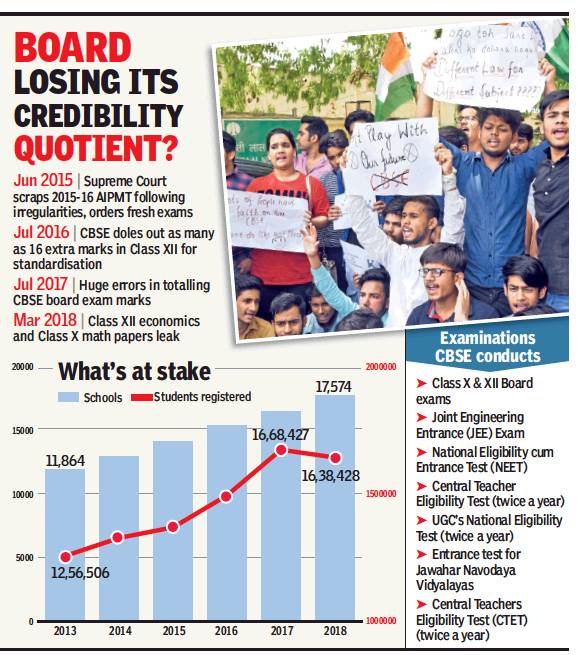
Number of schools and students registered-2013-18;
Examinations CBSE conducts
From: Manash Gohain, As leaks mar CBSE’s report card, experts link slow reforms to crisis, April 3, 2018: The Times of India
Say Steps Outlined To Firm Up System Under 2005 Framework Should Have Been Continued
The All India Pre-Medical Test conducted by the Central Board of Secondary Education in 2015 was cancelled by the Supreme Court. The high marks given by the board in the Class XII exams in 2016 drew a lot of flak. And while 2017 was dogged by big marks calculation errors in the board exams, this year saw the question paper leaks. Experts have observed this downslide in the past few years and attribute it to the non-sustenance of the reforms in examination and evaluation that CBSE initiated after the National Curriculum Framework in 2005.
Professor Krishna Kumar, former director of NCERT, said these controversies point at problems within the education board. “Under chairman Ashok Ganguly, CBSE started work in 2005 to improve the evaluation system and revamp the system of setting question papers, but gave up too soon,” Kumar said. “CBSE should have created space for thoughtful answers instead of textbook answers, but that requires direction and it did not happen. After 2009-10, the momentum was lost.”
Kumar added that the Indian public examination system anyway lacked credibility because of the marking system and practice of having module answers by which to judge students. “Our system has sanctioned this, and every year there are cases of children getting their answer sheets re-evaluated because they feel they have not been treated fairly,” he pointed out. “This year, CBSE created more uncertainty among the students on whether their hard work was being rewarded.”
Ganguly himself felt this year’s examination fiasco was an aberration. “The faith in the infallibility of the system may have led to this situation,” Ganguly said. Citing the pioneering system of having multiple sets of question papers, which many state boards too adopted, the former CBSE chairman reasoned, “CBSE discontinued multiple sets in 2018 without thing it much thought. Had we followed the multiple set system, the severity of the leaks would have been reduced and it would also have pinpointed the mischief monger.”
National Curriculum Framework outlined measures for exam reforms and CBSE should have not only sustained the changes, but improved upon them, said Ganguly.
Many felt that the question paper leaks were organised attempts to malign the existing set-up. “While it is premature to speculate about such motives while the investigation into the origin, methodology and intent behind the leak are under way, it is nevertheless obvious that the big-bang is pretty well organised and its primary intent is to malign the system that has worked for decades with impeccable records, efficiency and credentials,” asserted Ashok Pandey, principal, Ahlcon International School, Mayur Vihar.
Pandey said asking for the head of the CBSE chairperson would not address the problems at hand. He said that going forward, the education board needed to “revisit the assessment process, introduce reforms, integrate technology and bring
uniformity in the evaluation system” from Class I to XII. “The continuous and comprehensive evaluation (CCE) system, therefore, was not such a bad idea. But we discarded it abruptly,” Pandey rued.
Professor Janaki Rajan, department of teacher training, Jamia Millia Islamia, pointed out another drawback. “CBSE no longer has academic presence which is crucial to understand curricular, pedagogic evaluation and measurement dimensions,” he said. “These require research-based organic and child-centred approaches rather than administrative and logistic approaches.”
Disabled candidates
Largest number of disabled CBSE examinees is from Delhi
Jan 05 2015
Most disabled kids in CBSE exam from city
Shreya Roychowdhury
The largest number of disabled candidates appearing for classes X and XII evaluation under Central Board of Secondary Education (CBSE) is from Delhi.The state-wise count of students with disabilities, released by the Board also showed that the number of differently-abled students appearing for evaluation has been rising steadily . A total of 743 candidates appeared in Class X exam in 2009 in Delhi and more than double the figure appeared in 2014.
There were no registrations of autistic students in Class X from 2009 to 2013 from Delhi, but there were five in 2014. Similarly, numbers of students with visual impairment or dyslexia have also increased significantly over the six years -from 214 to 403 in case of blind students and from 93 to 423 in case of those with dyslexia. For the Class XII exam, the biggest jump was in case of orthopaedically challenged students. CBSE categorizes them as “handicapped“. In 2009, 272 mobility-impaired candidates from Delhi appeared for Class XII evaluations; the figure rose to 524 in 2014. The number of hearing-impaired students jumped from 25 in 2009 to 130 in 2014.
One of the reasons for the huge difference between Delhi and runners-up Uttar Pradesh, Kerala and Madhya Pradesh is that in Delhi majority of schools are CBSE-affiliated. There is no state board and government schools too come under CBSE.
“Inclusive education is strong in Delhi,“ George Abraham of NGO Score Foundation said adding, “There are more visually challenged students in mainstream schools in Delhi than in any other place in the country. It also depends on the support services, availability of reading material and trained teachers. Delhi is more education-friendly, more aware,“ he said. “Even CBSE is good at handling things here as regional officers are always well-equipped.“ He recalled the case of a student in Surat who was not allowed to use a computer to write his exam.“They were telling him to go to Ajmer. We managed it, but regional offices are not necessarily in sync with the headquarters.“
Madhumita Puri of Society for Child Development, Delhi, said most of the students who have been successfully appearing for these exams are either from private schools or from National Institute of Open Schooling (NIOS). “Sarva Shiksha Ab hiyan has helped and so has stricter implementation of 3% reservation in jobs,” Puri said, “The well-to-do always send their disabled children to school. Now, poor parents too have been making an effort.”
In case of Delhi, the number of students, who appeared for CBSE evaluation in Class X, is close to the num ber appearing in Class XII two years later.
A total of 743 students appeared in Class X evaluation in 2009 and 741 appeared in Class XII exam in 2011. Either the attrition rate is low with those completing Class X choosing to remain in school, or students from other states, where there is a dip in number, are moving in to Delhi.Puri said, “There is a huge migration of visually-impaired students into Delhi, but very little in the other categories.“
January 2018/ Relief for diabetic examinees to stay: CBSE
Relief for diabetic examinees to stay, CBSE clarifies, January 24, 2018: The Times of India
The Central Board of Secondary Education stated that the concession for students with Type 1 diabetes when they sit for the Class X and XII board exam will continue as per the circular issued on February 2017 and that they will not be clubbed with students categorised as persons with disability.
CBSE had started allowing insulin-dependent students writing their board exams to carry sugar tablets, chocolate, candies and water bottles to the examination centre. They were also allowed breaks to take these to avoid hypoglycaemia that could affect their health and exam performance.
This year, however, diabetic students appearing for the exams commencing on March 5 were asked to apply for the concession through an application form pertaining to students with physical disabilities. On Tuesday, CBSE spokesperson Rama Sharma refuted this and said no changes had been made in the concession process and no instructions were sent to school indicating any change in the guidelines.
“The rules remain the same. The students seeking concession for Type 1 diabetes need to follow the circular issued last year,” Sharma reiterated. An official said that the confusion had arisen after some schools asked their diabetic students to fill up the wrong concession form. According to the 2017 circular, a diabetic student was required to submit a certificate from a diabetic specialist along with details of the individual’s full diabetic history, nature of diabetes and the requirements for snacks during examination. There were to be forwarded to CBSE by the principal of the school in which the student was enrolled.
Dr Ashok Jhingan, chairperson of Delhi Diabetes Research Centre, said that in order to avoid any confusion in the future, the education board should create a separate category to allow for “specific reasonable concessions” for diabetics and have a standard format for all schools to follow.
Examination formats
Classes VI to IX
2017-18 onwards
Manash Gohain, CBSE unveils new exam format for classes VI to IX, Mar 22, 2017: The Times of India
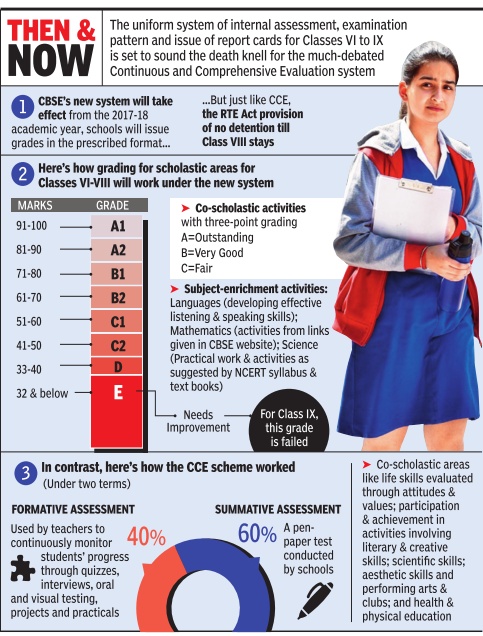
CCE Junked, Changes From Coming Year
The Central Board of Secondary Education has formally junked the continuous and comprehensive evaluation (CCE) scheme for classes VI to IX, being followed in affiliated schools since 2009. Replacing it from the coming academic year (2017-18) is a new format -`uniform system of assessment, examination and report card' -that aims at standardising teaching and evaluation across schools.
All students will be under a “uniform assessment“ process from Class VI onwards and schools will have to adhere to CBSE's template, from examinations to report cards, which will now bear the logo of the board.
CBSE said schools under its fold have been following various systems of assessment and examination in classes VI to IX. The changes being brought in are also linked to the restoration of the Class X board examinations from 2018, said board chairperson R K Chaturvedi.
The new format, he said, is a “gradual movement towards quality education through standardisation of teaching, assessment, examination and report card“.
Chaturvedi added that uniform standards had become imperative because disparities in the system were creating problems for students whenever they migrated to another school.
“With the increase in CBSE affiliated schools from 309 in 1962 to 18,688 at present, a uniform system will ensure easy migration of students within the CBSE schools and also ease their difficulties while seeking admissions in new schools,“ Chaturvedi said.
The new report cards for classes VI to VIII will be identical with rows which specify the terms, periodic, notebook, subject enrichment and half yearly yearly marks scored in each subject and the corresponding grades. It will also have co-scholastic assessment where students will be graded on a 3point scale. The format changes in Class IX where the report card will have scores of a single yearly term comprising a periodic test, notebook, subject enrichment and annual examination. The co-scholastic grading will be on a fivepoint grading scale.
Under the CCE scheme students were assessed based on two term-end `summative assessments' and four `formative assessments' (two each in each terms). Sixty percent of the assessment was pen-paper tests, while 40% formative assessment during the year was continuous evaluation by teachers based on various activities.
The new scheme too has two terms, but the pen-paper test weightage will be now 90%, which includes the 80 marks of the half yearly or yearly exam and 10 marks of the 20 marks set aside for periodic assessment in each term.
Each term will be of 100 marks of which 10 marks will be for note book submission and subject enrichment (five marks each) under periodic assessment. While the half-yearly (term 1) exams for all the classes from VI onwards will be based on syllabus covered till the exam time, the syllabus for yearly exams will have a slightly different format. These exams will in creasing cover more of term 1 syllabus, starting with 10% for Class VI, 20% for Class VII and 30% for Class VIII.
“This is to gradually prepare the students for Class IX and higher classes where they will have to appear for exams for the entire syllabus. But it will happen gradually ,“ said Chaturvedi.
Class XII
2015: CBSE exam pattern adopted
The Times of India, Nov 21 2015
CISCE rejigs syllabus, follows CBSE exam pattern
The Council for the Indian School Certificate Examination (CISCE) board revamped its syllabus, infrastructure and training methods, with an objective of centralising education. At its 58th annual meeting, the board decided to frame class 12 (ISC) question papers based on the CBSE pattern from 2018.
Sample question papers for the ISC exams in 2018 for physics, chemistry , biology and math have been prepared as per the CBSE pattern. For class 10 (ICSE), the syllabus for history , civics, geography , math and physics has been reviewed for 2018. This is to ensure it is relevant, flexible and meaningful in content.
The break-up of marks of the theory and practical components at the ISC level has been revised for the following subjects: Computer science, fashion designing, physical education, Indian music (Hindustani), Carnatic and Western music. The earlier figures of 50% (theory) and 50% (practical) have been changed to 70% and 30%, w.e.f 2016.
The sample papers for these subjects have already been sent to schools and are also available on the council website.
Examination malpractices
‘Leaked’ question papers, 2006, 2011, 2018
By Krittika.Sharma | Class XII Eco, Class X Maths exams to be held again: CBSE/ Question Papers Were Leaked, Admits Board | Thursday, 29 March 2018 | The Times of India
In 2006, police uncovered the leaked CBSE question paper of Business Studies, while it was searching for suspects connected with the Varanasi bomb blasts.
In 2011, three persons — Krishnan Raju (principal of government senior secondary school at Lapati, Car Nicobar), Rashid (executive engineer of the Andamans PWD), and Vijayan (a forest ranger) — were arrested on charges of leaking the question papers of the on-going CBSE exams. The question papers included those of Class XII Science and Mathematics.
Director General of Police (DGP), Andaman and Nicobar Islands, had dismissed a radio operator, M P Arun, for his alleged involvement in the leak.
2018: Within 90 minutes of the end of CBSE’s Class X Maths exam on 28 March 2018, the board declared that students will have to sit for a retest following reports of the question paper having been leaked.
Re-test will also be held for the Class XII Economics paper, which was also allegedly leaked, as reported by The Times of India .
The Maths paper leak was an embarrassment to CBSE, as the Class X board exams were being held after eight years. Sources said the board was apprised of “another” probable leak on Tuesday night itself.
A CBSE statement said the board had taken cognisance of “certain happenings in the conduct of certain examinations”. It decided to re-conduct Class X Maths and Class XII Economics papers to “uphold sanctity of the board and in the interest of fairness to the students.”
While TOI received a handwritten version of the Class XII Economics paper on the day of the exam (Monday), the leaked Maths paper (also handwritten) was sent to this reporter on Tuesday night itself. It was received at 9.10 pm.
TOI had earlier reported that it had access to a handwritten paper, alleged to match with Set 1of the CBSE Economics paper that the students had sat for on Monday. The Class X Maths paper too had been circulated widely in teacher and student groups, with some children in Bihar and Abu Dhabi also claiming that they had access to the “leaked” paper.
However, this was not the only version of the leaked paper doing the rounds. Students TOI spoke to had scans of a printed exam paper that they claimed had been sent to them on Tuesday night. Students said many questions from the “leaked” exam paper figured in the actual Class X Maths paper.
The handwriting in the leaked Maths paper sent to TOI was different from what has been sent in the case of Economics and Biology.
A similar allegation of paper leak was made during the Class XII accountancy exam, which was also acknowledged by Delhi deputy chief minister, who ordered an inquiry into the matter. However, CBSE had denied that any leak took place, claiming that “all seals were intact at the centres”.
Sources claimed that question papers of several other subjects had also been leaked during this year’s CBSE exams.
Significantly, the retest for the two exams has been notified for all CBSE schools — across India and abroad. According to CBSE spokesperson Rama Sharma, this year all papers that we sent across Delhi, India and abroad had the same set of questions. This was a break from the norm, wherein four different groups of papers are made for Delhi, rest of India, schools outside India, and one for reserve. However, according to sources, since the paper was the same for all students, the damage is also large-scale.
2019: How CBSE plugged paper leaks
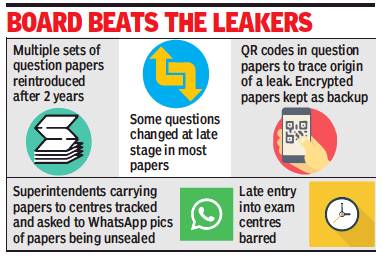
From: Manash Gohain, Multiple papers, QR codes, live tracking: How CBSE plugged paper leaks this yr, March 27, 2019: The Times of India
If all goes well, the board exams will end this week without a paper leak. All of the leak-prone exams, such as maths and the sciences, have been written, but officials at Central Board of Secondary Education (CBSE) aren’t celebrating yet. A last-minute slip could leave them red-faced like 2018.
A string of leaks had marred the 2018 CBSE boards. Besides the Class XII economics paper, which had to be held again, the Class X maths paper was leaked. Images of solved question papers of some other subjects also went viral.
For starters, the system of multiple sets of question papers was reintroduced after two years. This seemed like an easy fix and wouldn’t have stopped leakage during handling. The board, therefore, adopted new technologies and other measures to make its system leak-proof.
Not only were the questions reordered to make different sets, a few new questions were also inserted. This has never been done before. A CBSE official said some paper sets had up to 30% new questions. Some papers even had more than three sets.
Question papers also came with QR codes to trace the origin of a leak and stop its spread. And encrypted papers were kept ready as backup. “The encrypted papers can be sent to most centres online within minutes,” said a CBSE source.
The board also tracked exam centre superintendents carrying papers to the centres. To maintain a record of the time when each set of question papers was opened at different centres, the superintendents were asked to WhatsApp pictures to the monitoring room.
Campaign against fake news a success
The board’s monitoring cell worked overtime to keep tabs on social media, especially Youtube and WhatsApp. Within the first four days of the exams, it found 17 weblinks on Youtube falsely claiming to sell original papers. It lodged an FIR with Delhi Police on March 6.
“In all, we found 47 such links that claim to either sell question papers or use the CBSE logo to create panic and confusion among students. We have posted the links on our official website to alert students and parents,” said the source. The Board also ran a campaign to make students aware of fake news regarding paper leaks and availability of leaked papers on social media.
Finally, a simple change to exam hall timings left no opportunity to make use of leaked papers. While earlier, students could enter up to half an hour late, this year they had to be seated by 10.15am for exams that started at 10.30am.
“Most students are now seated by 9.50am and no movement is allowed inside the centre by 10am, when the question papers are sent to the classes,” said the official.
Examination reforms
Re-evaluation system abolished/ 2017
HC Had Slammed Board's Selective Policy In February
After three years of what was touted as the most radical exam reform by Central Board of Secondary Education, the board has decided to do away with the re-evaluation process completely . Several schools and students have called it a regressive step.
The board, however, is continuing with the verification (re-calculation) of marks, online application for which opens on Wednesday . If one doesn't apply for verification, they can't obtain a photocopy of the answersheets either.
Delhi high court had in February upheld a student's right to be re-evaluated in all subjects and questions. A bench of then Chief Justice G Rohini and Justice Sangita Dhingra Sehgal had also pointed out that students had the prerogative to get their answersheets re-evaluated to ensure proper assessment was done and that “it would lead to discontentment and frustration if the students who put in a lot of effort don't get the results they expect“.
On February 4, HC struck down the board's selective reevaluation policy that restricted students from availing the option in just 10 subjects and 10 questions per subject. The court termed CBSE's decision as “rather eccentric“ as it “first provided for the facility of re-evaluation to the candidates and, thereafter, put unreasonable restrictions“.
As long as the policy existed in the bylaws of CBSE, it could not whittle down and restrict the number of questions or subjects that could be re-evaluated, it noted.
In 2014, CBSE had decided to allow Class XII candidates to not only get a photocopy of their evaluated answersheets, but also seek re-evaluation instead of just a re-count of marks. It started with seven subjects -English, Hindi, physics, chemistry , mathematics, political science and eco nomics -which was later extended to 11subjects in 2015.
The principal of a private school in south Delhi said: “ A student is entitled to get the manuscript. After that if he she, or any expert, finds a mistake in evaluation, how can CBSE deny a remedy?“ Till 2016, a candidate first had to apply for verification of marks, followed by an application for photocopy of the answersheets. Finally , one could apply for re-evaluation. Now, “there will be no re-evaluation of any evaluated answer. However, if any answer has not been evaluated, the same would be reported by the candidate to respective regional offices of CBSE not later than seven days of receipt of the photocopy of the answerbook“.
The principal of another private school said: “The government talks of transparency and good governance, but this is another regressive step by CBSE. Re-evaluation helped many students in the last three years.“
TOIcame across a number of cases where re-evaluation helped rectify errors. For example, Vikas Kapoor (name changed), now a third-year history student at St Stephen's College, managed to make it to the college after his English score was increased from 90 to 95 after re-evaluation.
CBSE brings back re-evaluation: 2018
Manash Gohain, CBSE brings back re-evaluation, June 2, 2018: The Times of India
CBSE has reintroduced the option of seeking re-evaluation of answers for this year’s Class XII and X exams. Candidates can apply online for the process, which begins with rechecking of answer sheets, from Friday.
In 2017, CBSE had done away with re-evaluation, which prompted students to approach the Delhi high court. On HC orders, the board had allowed re-evaluation on a “first come, first serve” basis.
The board has also made the certificates of all 28 lakh candidates available online on DigiLocker within hours of the result being declared. Safety features on the site will help detect fake certificates.
Seeking re-evaluation is a three-step process. Candidates have to first apply for rechecking and then ask for a photocopy of the answer sheet before being eligible for reevaluation.
Get your marksheet on DigiLocker
Students seeking rechecking can apply and make payments online from June 1 to June 5. Announcing the dates, HRD secretary Anil Swarup tweeted, “Rechecking/ re-evaluation process and details for Classes X and XII CBSE examinations now available on CBSE web portal.”
The process, however, isn’t cheap. For rechecking (which is a recount of marks), an applicant will have to shell out Rs 500 per subject. The cost of getting the photocopy of an answer book is Rs 700 for Class XII and Rs 500 for Class X. For re-evaluation, applicants have to pay Rs 100 per question for both classes.
Students who apply for rechecking will get their results by June 14, 2018. Thereafter, they can seek a copy of the answer sheet on June 15 and 16, 2018. The copies will be sent by June 20, 2018, the board said.
Candidates who undergo these two processes can apply for re-evaluation on June 21 and 22. “Re-evaluation will be completed at the earliest,” said Swarup, without giving a last date for the results.
In 2014, CBSE had decided to allow Class XII candidates to not only get a photocopy of their evaluated answer sheets, but also seek re-evaluation instead of just a recount. It started with seven subjects — English, Hindi, physics, chemistry, mathematics, political science and economics — which was later extended to 11 subjects in 2015. Re-evaluation was stopped in 2017.
However, in February 2017, the high court upheld a student’s right to be re-evaluated in all subjects and questions. The court also struck down the board’s selective re-evaluation policy that restricted the option to just 11 subjects and 10 questions per subject.
A bench of then Chief Justice G Rohini and Justice Sangita Dhingra Sehgal termed CBSE’s decision as “rather eccentric” as it had “first provided the facility of re-evaluation to candidates and, thereafter, put unreasonable restrictions”.
In June 2017, CBSE gave an undertaking in the HC that it would relax its verification scheme to allow students to approach it for scrutiny of answer sheets and that all requests by students would be considered on a ‘first come first serve basis’.
Meanwhile, officials said the board has for the first time made all marksheets, pass and migration certificates available in students’ digital lockers within hours of the declaration of results. These digital documents are digitally signed, DigiLocker verified and also have safety features such as QR codes.
While on one hand the students can get the documents from the issuer (CBSE) online, they can also share digital versions of the verified documents with educational institutions and employers.
According to CBSE officials, already over 5.27 crore Class X and XII CBSE marksheets, pass and migration certificates of more than 2.31 crore students from year 2004 onwards are available in digital format.
Grade inflation
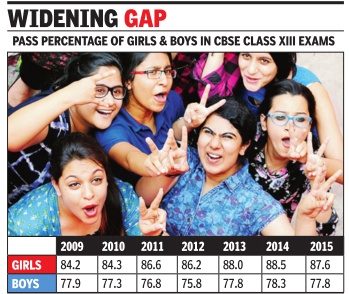
2009-16
See graphic.
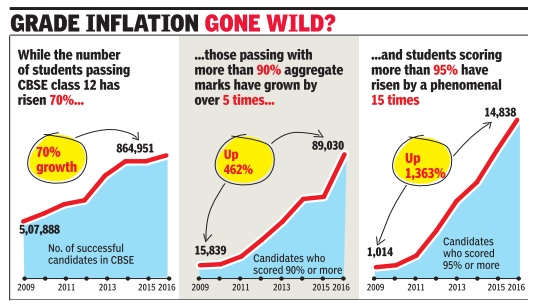
2013-17
Manash Gohain, What's behind the great Indian marks race , June 11, 2017: The Times of India
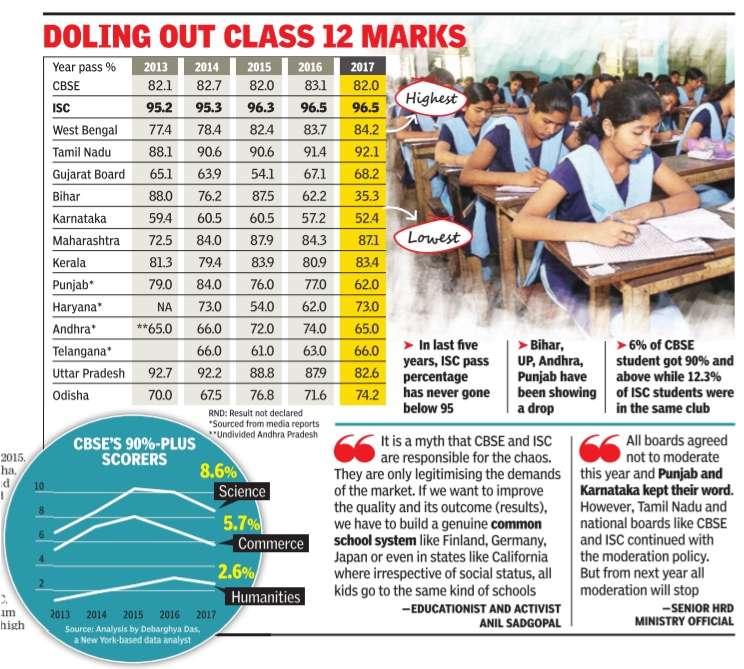
As school boards competitively inflate Class XII marks, it becomes hard to tell the best students apart
In the annual drama of the Class XII results, there are stories of cel ebration, heartbreak and injustice. The vari ation in results between various school education boards hurts students.Data over the last five years makes it clear that some boards have been competitively generous, in terms of the pass percentage as well as the proportion of high scorers (90%-and-above in aggregate).Other boards have swung in the opposite direction.
In the last five years, the pass percentage for Class XII exams conducted by the Council for the Indian School Certificate (ISC) has never dropped below 95%, while that of Tamil Nadu State Board has been above 90% since 2014.Other boards that consistently notch 80% and above in pass percentage are the Uttar Pradesh Board, Kerala Board and Central Board of Secondary Education, with West Bengal joining the league in 2015.Andhra, Telangana, Odisha, Punjab, Haryana and Bihar are on the other end of the spectrum.
And it's not just that more students are passing, they're scoring more too. In every year since 2013, over 10% of students have been scoring 90% and above in ISC.There has been a quantum leap in the number of high scorers for boards like CBSE, Kerala and Tamil Nadu as well. These four boards alone have 1,01,822 students this year who scored 90% and above in Class XII exams.
The mandate of the school education boards primarily is to set question papers and conduct fair examinations. Over the years, overzealous boards have decided to give an edge to their students, whether for entrance examinations or for merit-based admissions. Ashok Kumar Pandey , principal, Ahlcon International, Mayur Vihar and winner of National Teachers' Award 2014, says the data only con firms that students appearing for board examinations across the country have had to suffer the vagaries of examination and evaluation system. “The differences in curriculum, question paper setting and quality of evaluation have a huge bearing on the overall performance of these children,“ points out Pandey .
The variations in question papers and evaluations and, therefore, in the final results, come from the way the National Curriculum Framework (NCF) itself is understood, says Pandey . “What level of understanding and application of that topic is to be presented differs from board to board. And this is where variations at all levels crop up,“ he explains.
A common curriculum and a stronger Council of Boards of School Education in India (COBSE) could be a way forward, according to some experts. COBSE did work on a common core curriculum for mathematics and science in 2011-12, which was supposed to have been implemented by all boards but wasn't. The plan is now being revisited by the HRD ministry .
Most blame the marks chaos on the inflated merit-based cutoffs to make it to colleges and universities.
The purpose of board examination is very different from that of a competitive examination, point out experts.The board exam is used to assess how good a student is at the curriculum prescribed for the relevant classes; it is an achievement test. On the contrary, competitive examinations are a test for the elimination of weaker students. It has been seen in the past that many students who have done well in the board examinations may not do well in competitive examinations and vice versa.Therefore, using board exams alone as a means for admitting students to Delhi University or other colleges may not be ideal, since the exam is not designed for that objective.
Also, using the board examination marks to select students across various boards is discriminatory, since the marks obtained by the students depend on the syllabus, the method of teaching, scheme of examination, typology of question paper and the moderation policy followed by the board. Moderation is meant to be used to smooth any discrepancy in the result that might occur because of wrong questions, varying levels of difficulty between questions papers, and other vagaries in the examination. Under the pretext of moderation, school education boards started spiking marks, some doling out as high as 16 marks per paper.
Claiming that Delhi University was one of those responsible for the “competitive spiking of marks“, former CBSE chairperson BP Khandelwal says: “Now it's because of DU.However, it all started with BITS Pilani admissions when even the UP Board topper never used to get admission.“
He stresses that exam evaluation and its moderation process should not be guided by the university admission process. Since the situation is different in every state, COBSE should come in strongly to build a fair system. “Quality education is one of the biggest challenges and if we don't attend to it now, we will have to deal with the damage done in 2030,“ he adds.
Meanwhile, the deluge of 90-plus scores makes it difficult to judge students, and hurts the truly deserving. Grade inflation, like regular inflation, is when the same marks -say 90 -are worth less because more people are given that, explains data analyst Debarghya Das. Unlike regular inflation, it is problematic because the maximum marks you can achieve is capped at 100. He explains this with a potatoeating contest analogy. “In regular inflation, perhaps participants will be able to eat more potatoes over time because the size of the average potato gets smaller. This is okay , because the best potatoeater will still eat more. In grade inflation, I have the same potato-eating contest but the maximum number of potatoes per participant is 20. Now, as the potatoes become smaller, most of my participants eat all 20 potatoes, just like most students get 90+ marks. Therefore, as a judge, it's impossible to tell who's a true potato eating champion and who is not!“
’Moderation’ of the marks score by candidates
2017: Moderation limited to 3-4 marks
Moderation limited to 3-4 marks: CBSE, May 29, 2017: The Times of India
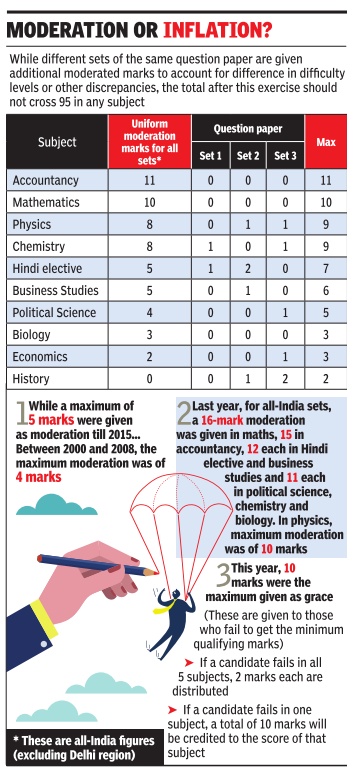
Drop in 90%+ Numbers, Rise in 95-Percenters
After capturing pole position in 2015, girls continued to dominate the CBSE Class XII results. For the third consecutive year, the all-India topper is a girl.
In fact, three of the top four rank-holders across India are girls. The seven-member elite club of 99-percenters has five girls this year. FULL COVERAGE: P 4, 5 & 6 A total of 10.2 lakh students appeared for the exam.For the fifth consecutive year, a student from Delhi-NCR topped the Class XII boards.Raksha Gopal of Amity Noida bagged the honour, scoring 498 marks out of 500 (99.6%) in humanities.
The overall pass percentage dropped by 1.03 percentage points compared with last year. Thiruvananthapuram continued to have the highest pass percentage (95.63%), while Jawahar Navodaya Vidyalayas (95.73%) were the best among institutions.
While nearly nine out of 10 girls appearing for the exam passed, over 20% of the boys failed. Girls (87.5%) maintained a lead over boys (78%) in terms of pass percentage and also bagged the top positions.Even among the top three performers in the differently abled categories, two are girls.
With a perfect 100 in three subjects -English, political science and economics --and 99 out of 100 in history and psychology , Gopal told TOI that luck plays an important role in securing good marks. Raksha said, “Hard work is essential but one has to have good luck as well. The Class XII result is not the end of the road for students. If one is relaxed and puts in hard work, they can achieve what they want.“
Bhoomi Sawant from DAV , Sector-8, Chandigarh, is the all-India science topper, and second overall, with a score of 497. Aditya Jain and Mannat Luthra, both from Bhavan's, 28-B, Chandigarh, topped the commerce stream and are joint third with 496 marks. Ajay J Raj from Thiruvananthapuram, Lakshmi PV from Palakkad (both in Kerala) and Dharshana MV from Krishnagiri, Tamil Nadu, are the three toppers in the differently-abled category with scores of 490, 486 and 483, respectively .
The other three students with 99% (495 marks) this year are Sanat Goel from Bhavan's, 28-B, Chandigarh, Ramya Kaushik of Dewan Public School, Westend Road, Meerut, and Devika C of K M B Vidya Mandir, Thrissur, Kerala.
While most trends remained unchanged, the number of students scoring 90% or more dropped for the first time in a decade to 63,247. Last year, 140 more students were in this marks bracket. However, the top continues get crowded with 10,091 students scoring 95% and above, which is 740 more than last year.
This year, just ahead of the declaration of the results, the Delhi high court had on May 22 restrained CBSE from doing away with moderation of marks. The ruling came following a decision by 32 school education boards (including CBSE) reached a consensus on April 24 on not moderating marks and spike the scores this year.
“As ordered by the Delhi HC and advised by the legal counsel, we continued with the moderation policy . However, there has been no spiking of marks which is evident from the number of 90% and above scorers, which has otherwise been increasing for last 10 years,“ said a senior CBSE official, while stating that moderation has been restricted to three or four marks in 2017.
2017, incidents: ’Moderation’ of the marks score by candidates
In 2016, CBSE gave 16 `extra marks' in maths , May 18, 2017: The Times of India
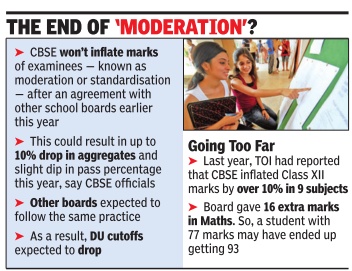
As first reported by TOI, CBSE gave as many as 16 extra marks in the Class XII Maths exam in 2016 in the all-India set of papers and 15 marks in the Delhi set during the process of `standardisation'.
In nine subjects, marks were `standardised' by more than 10%. As a result, a stu dent with 77 marks in mathematics may have ended up getting 93 marks.
In 2016, the pass percentage for CBSE had touched an all-time high of 83.05% and over 80,000 students scored 90% and above.
While moderation of marks has always existed to even out different levels of difficulty and other factors in an exam of such huge scale, sources said the exercise was conducted judiciously in the past. “It would never lead to an increase of more than five marks,“ said a former CBSE chairman.
Following reports of a spike in marks via moderation last year in 2016, former CBSE chairman Ashok Kumar Ganguly called upon the HRD ministry and Council of Boards of School Education in India (COBSE) to intervene.
Huge jumps in marks being given both via `moderation' and 'grace' liberally, according to the former CBSE chief, which was “against the spirit of moderation“.
CBSE awards up to 11 extra marks in a subject
Board Also Raised Grace Limit To 10Earlier, Only 1-3 Marks Used To Be Added
Ordered by the court to restore moderation of Class XII marks this year, the Central Board of Secondary Education (CBSE) seems to have gone way beyond reasonab le limits of the policy while awarding marks. Up to 11extra marks were given in accountancy , 10 in mathematics and eight each in physics and chemistry , documents accessed by TOI reveal. This is apart from set-wise moderated marks awarded due to differences in difficulty levels and other discrepancies. The spiking, evidently done in anticipation of other boards doing the same, is bound to reopen the moderation debate.
One expert called it “not moderation, but competitive inflation“ of marks. Others said spiking of marks was putting an otherwise progressive policy (moderation) under a cloud, with all boards getting into competitive mode. CBSE also gave up to 10 marks as gra ce to candidates who failed to get qualifying marks. TOI accessed documents on CBSE's moderation process this year for all India sets of question papers for 18 subjects. There were set-specific ex tra marks given to the same question paper(s).For example, while physics has been awarded eight marks as moderation, for `set 2' and `set 3', an additional one each has been awarded. Speaking to TOI, former CBSE chairperson Ashok K Ganguly said that such variability in mean marks among different sets of question papers should not have arisen in the first place. “These cannot be moderation of marks if the process has been done properly . Earlier, moderation of one to three marks used to be adequate,“ he said.
Stating that moderation is a necessity for a national board such as CBSE, Ganguly said it should be done judiciously .“State boards should not be moderating at all,“ he added.CBSE had stated it would not moderate marks this year.However, on May 22, 2017, the Delhi high court overturned the decision. Following the court's order, CBSE continued with its “moderation policy“ and the Class XII results were notified on May 28, 2017.
The board's grace marks policy (for those candidates failing in a subject) too was `liberalised' this year. As per CBSE documents with TOI, a total of 10 marks were awarded to candidates as grace. According to a former controller of examination, “grace marks used to be three or maximum four till around 2009“.
In the wake of this year's moderated marks, a former CBSE chairperson has called for reviving the Council of Boards of School Education in India (COBSE), a voluntary association of all the school boards. “It seems that COBSE has become dysfunctional. Its mandate was to create a levelplaying situation. The body should be revived and the human resource development ministry should intervene, along with state education ministers, to ensure that the 2018 board results are different,“ he said.
The ministry of human resource development and the CBSE have not been on the same page over the decision to do away with moderation even though the ministry agreed various boards were “spiking“ marks. But the ministry's view that the decision be implemented from next year to avoid complications did not find favour with the CBSE.
The ministry is similarly worried that the decision only to re-total and not re-evaluate has been taken without taking into consideration the interests of students and may create resentment if it was not fully explained.
In the moderation controversy , ministry was able to prevail on the CBSE not to challenge the high court decision in the Supreme Court so as to avoid a delay in declaration of results. But the board, an autonomous institution under the MHRD, did not heed caution in announcing scrapping of moderation. According to HRD sources, the ministry and the board had major differences as the minister asked CBSE to work on the policy only after detailed consultation and implement it from 2018.
A former CBSE Chairman’s view
Ashok Ganguly, Make moderation process transparent, May 25, 2017: The Times of India
Don't ban it if you want to rid the exam system of discrepancies
The problem today is that the school examination system has also become a victim of consumerism. In a social milieu that values marks more than the development of personality , it is not `learning' but `scoring' that gets glorified. Besides, when a system relies on elimination rather than selection for higher studies and even for jobs, there automatically is a race for marks. So even if a student gets 94%, his parents are not happy and they want the result verified.
With a steady decline of high er education across the country , Delhi University remains a hope for today's youngsters. The main reason why marks of Class XII board examinations started being inflated was because Delhi University follows a process of elimination rather than selection for admission in undergraduate classes. Inflation of marks became more pronounced after 2008 when some state boards began increasing marks to help their students get an upper hand in the elimination process.
If the design and blueprint of the question papers of the country's 52 school boards -three national, the rest state-based -were flawless, then the performance of the students would show a normal probability curve or, at most, a bellshaped one in graphical representation. In such a situation, 4-5% students would get 90% marks or above. However, in some state boards, 25-30% of the students get 90% or more in some subjects, particularly English. Is this normal? And why English? Well because, English is one of the best four subjects considered for admission in undergraduate classes.
Only in this background is the decision of CBSE and some of the state boards not to allow moderation marks a welcome step. But I do not know how this will be implemented and which agency will monitor it. Some state boards have already declared their results and they have allowed moderation.
Moderation is usually done in three stages to minimise discrepancies in the system: first, moderation of question papers; second, moderation of marking schemes; and finally , moderation of the raw score, if necessary . Moderation should exist in some form, but must be full-proof and transparent. Once, the question papers were set by people from universities and colleges and moderation of marking schemes was done by practising schoolteachers.
Moderation is a scientific process and as long as moderation of question paper and moderation of marking scheme are done appropriately, there won't be any need for any moderation of marks in the third stage. And if at all moderation marks have to be awarded, they should only be 3-5 marks, depending on the difficulty level of a particular question paper set. It can never be awarded to students en masse in any subject.
At the root of all efforts to stop the inflation of marks in our ex amination is the issue of raising the awareness, confidence and competence of all stakeholders. If moderation is not implemented in the true spirit by all boards but only by a few, the latter's students are going to suffer in the by cut-throat competition. We have come to believe that the board examination is Aladdin's lamp and if we rub it, we will be able to materialise the genie that will, at our command, fulfill our wishes for the right marks, good college and a bright career. This genie has to be exorcised and it cannot be accomplished by cribbing with a fragmented view of the system.Highlighting unfortunate aberrations thrown up by the system serves no purpose except perhaps to heighten the fear perception and hysteria among young minds.
The writer is an educationist and former Chairman of Central Board of Secondary Education
‘Pass norms’
2018: norms eased for Class X in subjects with internal assessment
Students appearing in Class X CBSE Board examination this year will be exempted from the mandatory separate pass criteria in the subjects having internal assessment component of 20 marks and 80 marks of Board examination. The Central Board of Secondary Education on Tuesday notified this one-time exemption.
The current batch of Class X students will sit for the Board exam on March 5, which will be the first mandatory public exam after eight years. The CBSE had introduced the Comprehensive and Continuous Evaluation (CCE) scheme along with optional Board exam. All others took the school-based exam.
The CCE system was revoked in 2017 by the Board and Class X Board examination was made mandatory.
According to the notification issued by CBSE chairperson Anita Karwal, the examination committee in its meeting recently decided to give the one-time exemption to the Class X students as they will be the first batch after the Board exam made a comeback. As per the “passing criteria” for the Class X students of the 2017-18 batch, “they need to secure overall 33% (both internal assessment and the Board exam marks taken together) in the subject to be able to pass”.
The same passing criteria will also apply in the additional subjects, provided they have internal assessment of 20 marks and Board examination of 80 marks.
This rule will also apply for students with subjects under National Skills Qualifications Framework scheme for the five major subjects — two languages, science, maths and social science.
The provision of replacement of subjects extended to the NSQF students “for the failed subjects (out of the three subjects – science, maths and social science) by the vocational subject (passed by the candidate under NSQF) would continue to apply”. However, for vocational subjects listed in Annexure I, which were notified on March 9, 2017, there will be no exemption from separate pass criteria as the internal assessment of these subjects comprise of 50 marks.
Principal, Appointment of
December 2016: CBSE gets a say in unaided schools
Manash Gohain, CBSE gets say in picking heads of unaided schools, Dec 23, 2016: The Times of India Private unaided schools affiliated to the Central Board of Secondary Education (CBSE) will no longer be able to appoint principals or heads on their own as the board has empowered itself to monitor such appointments in schools that fall under its ambit. Also, teachers aspiring to be principals will now have to qualify a Principal Eligibility Test (PET) conducted by the board, a circular said.
According to a CBSE circular issued to all state education directorates, school principals and other stakeholders, it will now be mandatory for schools to include a CBSE nominee and a state government nominee in their selection committees for principals.
Further, these committees will have to comprise five or more members instead of the four that were required till now, the new addition being that of the state government nominee. What makes this change significant is that the member with experience in school administration, hitherto nominated by schools' managing committees, will now be nominated by the chairperson of the CBSE.
This effectively means that out of the five members on the panel, two will be appointed directly by , or with the approval of, the CBSE.“Till now, it was the managing committee which used to independently pick the two, with the president of the society and the managing committee chairperson being the remaining two constituents. In case of pri vate unaided schools, the recruitment used to be completely in the hands of the school management,“ said a member of the central board's governing body .
Voicing concern at the apparent curtailment of autonomy , a principal of a private school in Delhi said on condition of anonymity , “This effectively creates a controlled regime. We don't really know how reducing schools' members in the selection committee will help them. The strength and kind of candidates vary from school to school. For that there should have been more autonomy . The CBSE and state government nominees are welcome, but that may result in delays.“
Re-evaluation policy
Students can seek re-evaluation in all subjects: HC
Abhinav Garg, No Cap, Students Can Opt For All Subjects, Feb 05 2017: The Times of India
In an important verdict, the Delhi high court has struck down the Central Board of Secondary Education's selective re-evaluation policy that restricted students from availing the option in just 10 subjects and 10 questions per subject.
Spelling relief for students, a division bench comprising Chief Justice G Rohini and Justice Sangita Dhingra Sehgal termed the restrictions as “eccentric“ and said students can now seek re-evaluation in all subjects.
“It is rather eccentric to first provide for the facility of re-evaluation to the candidates and thereafter put unreasonable restrictions. The board cannot afford to ignore individual claims of re-evaluation at its whims or fancy , by merely `pick and choose' of subjects or number of questions,“ the bench observed while ruling in favour of two students.
The board had introduced a rule in its examination scheme to allow students to apply for re-evaluation, but restricted the number of questions and the subjects to be re-evaluated. By way of a notification in May 2015, CBSE brought out these rules after amending the by-laws, which the court found to be “manifestly unjust, unreasonable and partial“.
Pointing out the pitfalls of CBSE continuing with such a rule, the bench observed that it “would lead to discontentment and frustrations if the students who put in a lot of effort do not get the results they expect“ adding that “it should be the students' prerogative to get their answer sheets re-evalua ted in order to ensure proper assessment is done“.
In the process, the court upheld two separate single-judge verdicts. In one a single judge had faulted CBSE for allowing just 10 questions for re-evaluation, while the second bench ordered it to re-evaluate a student's physical education theory paper, despite the board claiming that PE is not covered under its subjects where re-look is permitted.
The board argued before the division bench that it sto res lakhs of copies after the examination, as many students apply for re-evaluation. Defending its restriction on number of questions and number of subjects, CBSE maintained it had to exercise some discretion, else will be flooded with such requests. It even cited certain Supreme Court judgments, to bolster its argument that it has the power to deny reevaluation of answer sheets.
However, the HC rejected its stand and noted that administrative difficulties of the board can't over-ride the future of a candidate.
CBSE had decided to scrap the re-evaluation of class XII answer sheets in 2016 and the court order is a setback. In 2014 it introduced re-evaluation in eight subjects, which it extended to 10 in the subsequent year, becoming the only board to facilitate this service.
There is a three step process wherein the student first needs to apply for recounting of marks if in doubt and thereafter he she can ask for the photocopy of the evaluated answer sheets. If not satisfied, the third step is re-evaluation of the answer sheet. All the three steps are linked and a student can't ask for re-evaluation without following the preceding two steps.
2016-18: totalling errors, region-wise
Manash Pratim Gohain, June 29, 2018: The Times of India
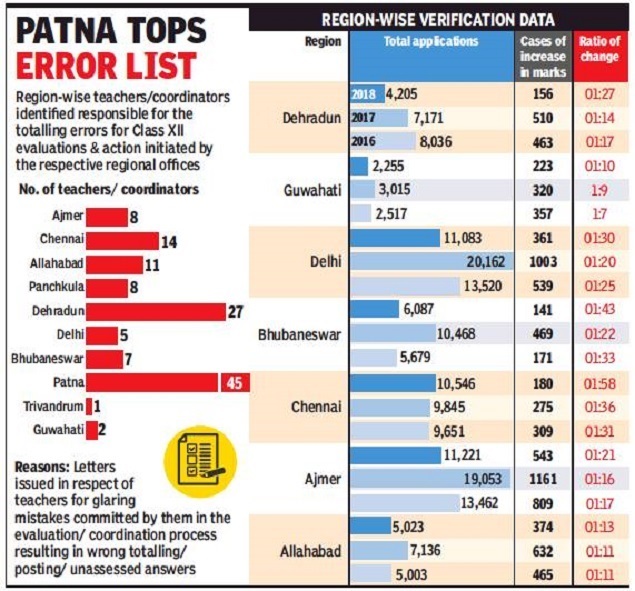
From: Manash Pratim Gohain, June 29, 2018: The Times of India
The Central Board of Secondary Education has initiated action against 130 teachers and coordinators across the country for evaluation errors and major mistakes in totalling marks awarded in the Class XII board exams.
The highest number of those who erred was in Patna region where 45 teachers/coordinators were held responsible for “the gross carelessness”. As the re-evaluation process gives over, more teachers could face action. TOI has, for the past three years, been reporting on how many students under the CBSE, which comes under the HRD ministry, have had issues due to errors in calculation of their board exam marks.
Though the number has decreased this year, TOI came across huge totalling errors and highlighted it in a report on June 24, which prompted the CBSE to probe the mistakes and start identifying, via its regional offices, the teachers/ coordinators responsible for them.
Based on data the board shared with TOI on Wednesday, of the 10 regions Patna has the highest number of erring teachers/coordinators. The Allahabad regional office has recommended action, including suspension, against 45 teachers/coordinators (from Patna region).
Patna is followed by Dehradun with 27 erring teachers/coordinators. Ajmer region has the most cases where marks have been increased after verification, followed by Allahabad and Delhi.
50% students got more marks on re-evaluation/ 2016-18
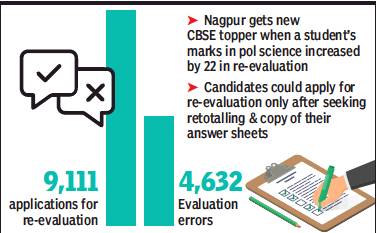
From: Manash Pratim Gohain & Abhishek Choudhari, 50% Class 12 CBSE students who asked for reval got more marks, July 25, 2018: The Times of India
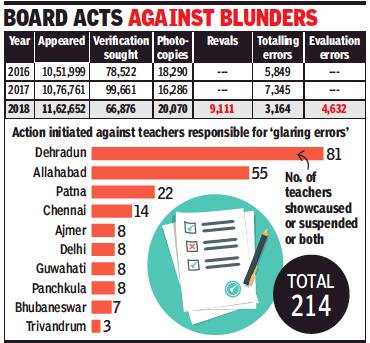
From: Manash Pratim Gohain & Abhishek Choudhari, 50% Class 12 CBSE students who asked for reval got more marks, July 25, 2018: The Times of India
Action Against 214 Teachers For Blunders In Evaluation
Ishrita Gupta is the Class XII CBSE board topper in Nagpur today because she didn’t accept her low marks in political science, and opted for re-evaluation. A brilliant student, Ishrita had more than 95 marks in all other subjects. Sure enough, re-evaluation showed 17 of her answers had been incorrectly marked, and her score increased by 22.
Rohit Malik (name changed) from Delhi also saw his marks go up after re-evaluation as he had not been scored on three correct answers. These are not isolated cases. In fact, every second applicant for re-evaluation this year has gained marks.
In all, 9,111Class XII candidates applied to have their papers checked again, and evaluation mistakes were found in 4,632 cases.
The common mistakes include giving zero marks for correct answers, and not evaluating a series of answers.
CBSE has initiated action against at least 214 teachers for “huge” blunders . Of these teachers, 81 are under the Dehradun regional office, and 55 under Allahabad.
Students can apply for reevaluation only after seeking retotalling. TOI had reported on June 24 that totalling errors were also high even though maths and computer science teachers were put on the job this year.
To prevent such mistakes, CBSE lets two teachers evaluate each paper, and board officials say the errors have declined. A comparison with previous years is not possible because, last year, re-evaluation was done case-by-case on a Delhi high court order, and CBSE has not shared data for re-evaluation in 2016.
Anurag Tripathi, secretary, CBSE, told TOI the twoevaluator system is successful as “99.6% of the copies are correctly evaluated.”
The 0.4% error rate, he said, exists because of the pressure on evaluators: “Around 50,000 evaluators are dealing with 61.34 lakh copies.”
Trying to keep students’ woes to minimum: CBSE
Tripathi said the board had decided to re-introduce re-evaluation this year so that students didn’t suffer due to errors.
“We have tried to minimise the errors, which right from verification to reevaluation are at an all-time low, and CBSE will continue its efforts,” he said.
However, school principals said the sharp increase in marks after re-evaluation is something new. The principal of a South Delhi school suggested that CBSE email answer scripts to students since evaluation is centralised and all the marks are uploaded online in real-time. “The process of retotalling and re-evaluation will become simpler as those whose copies are clean won’t apply.”
Re-evaluation reveals major errors in totalling: 2017
Jun 18 2017: The Times of India, June 18, 2017
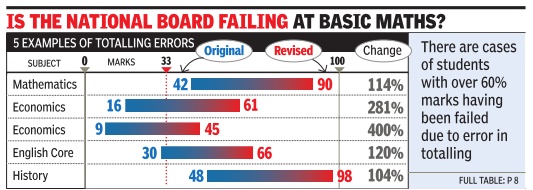
Up To 400% Difference In Original And Corrected Marks Raises Questions
Experts Say Re-Evaluation Need Of Students
A senior CBSE official admitted that the number of applications for verification of marks has been unprecedented, although he didn't reveal the exact number.
This raises two important questions. First, what is wrong with the totaling process and how fair is it for the CBSE to do away with re-evaluation altogether? CBSE currently only al lows verification while re-evaluation is possible only after a court order.
Ashok Pandey , chairperson of National Progressive Schools' Conference, an association of over 200 leading private schools in the country, strongly favoured a relook a the CBSE decision to scrap re-evaluation. “It is in the best interest of the students. CBSE, being the premier school education board in the country , should definitely take a lead in doing enough to bring in transparency,“ said Pandey .
Sonali, whose marks increased by 27 (from 68 to 95) post verification, pointed out that unlike her, students who were not very confident or scared didn't even bother going for the verification process. “As I wanted to pursue Economics (Honours), I had no option but to go for verification. However, many others didn't apply out of fear or thought that nothing will happen out of this exercise,“ said Sonali.
A senior official with the CBSE exam branch, while agreeing that there were mistakes in the process, said that the difference could be due to various reasons -mis takes in totaling of marks, incorrect transfer of marks to the title page (the front of the answer books) and detachment of supplementary answer books.
Parents level another criticism, saying that the CBSE's decision to link the two processes verification and obtaining photocopy of the evaluated answer sheet is anti-student. At present, only students who apply for verification can get a photocopy. “All students should be allowed to obtain their evaluated answer sheets and then if they want, they should be allowed to apply for re-evaluation,“ said a parent on anonymity .
Re-evaluation reveals major errors in totalling: 2018
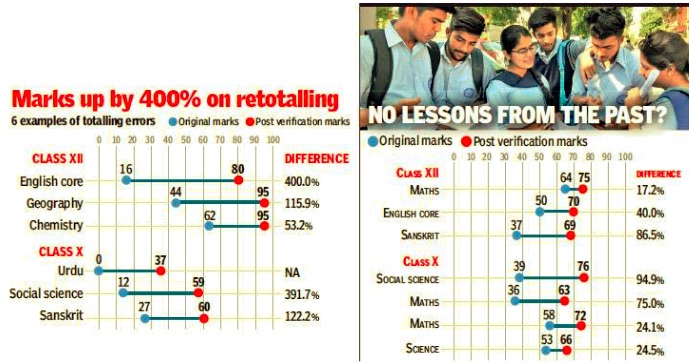
From: Manash Gohain, CBSE fails in basic maths again, leaves kids in lurch, June 24, 2018: The Times of India
On May 26, Meenakshi failed the Class XII boards with 16 marks in English core. Now, the Delhi girl is on her way to college as verification of her result showed CBSE hadn’t added up her marks correctly. She had scored 80 — a shocking difference of 400%. “Forget failing, I could not have scored anything less than 80,” Meenakshi said. “They didn’t add 64 marks, so all I got was 16, which has now become 80.”
Like last year, CBSE’s totalling errors are again torturing thousands of Class X and Class XII students. Although board officials aren’t saying how many applications they have got, and how many results have had to be revised, a source told TOI there are more than 10,000 requests for verification this year.
TOI had reported on the high incidence of totalling errors last year, too. A Mumbai student who scored 80% and above in all subjects had got just 50 in maths. After verification, his marks went up to 90. Delhi girl Samiksha Sharma’s maths score more than doubled from 42 to 90.
Embarrassed, the board had decided to assign two evaluators to each answer book this year, but the move clearly didn’t work. Amit, a Class XII student, scored only 44 marks in geography, but 90% and above in the rest. Verification showed 51 marks had not been added to his result, so his geography score increased to 95.
Chemistry marks go up from 44 to 95
Krish, who had failed in social science with 12 marks, now has 59, and is through to Class XI. A student who had scraped through in chemistry with 44 marks, has got 95, but the most shocking case is of a Class X student who scored zero in Urdu, only to pass with 37 marks after verification. How could the evaluators fail to credit this student for at least one correct answer? There are totalling mistakes even in the mathematics papers of both classes.
To a questionnaire about totalling errors, sent on Thursday, CBSE replied it is “not possible to give this data today” as they plan to collate it only after June 27. TOI also texted a questionnaire on totalling errors to CBSE’s chairperson and spokesperson on Saturday, but there was no official response till this report was filed.
Even the high-powered committee set up by the ministry of human resource development in April, after mathematics and economics papers were leaked, had expressed concern at CBSE’s evaluation process. An exam branch official said mistakes could occur not only due to incorrect totalling but also the incorrect transfer of marks to the title page (front of the answer book) and detachment of supplementary answer books.
Stationary, management
2017: Tuck shops can sell stationery
In a U-turn, CBSE allows tuck shops to sell stationery, August 31, 2017: The Times of India
In a reversal of its April order, the Central Board of Secondary Education (CBSE) has now allowed affiliated schools to sell “stationery and other materials required by students,“ from shops within their compounds.
The circular issued to all heads of the schools last Friday stated that in order to facilitate distribution of NCERT books, a `tuck shop' may be opened inside the premises of schools.The board in April had asked schools not to indulge in commercial activities by way of selling of books, stationery , uniforms, school bags, etc. The new circular, dated August 25, 2017, stated: “The NCERT, in order to augment the availability of NCERT books for the students of CBSE affiliated schools, has called for indent through their website for purchase of books as per the requirement assessed by the schools.“ It has also advised the schools to register and place their demands for textbooks for the academic years 2018-19 through the online portal of NCERT launched recently .
The board in its circular stated that since schools were allowed to place indent for purchase of the books directly through the NCERT website, the schools may open a `tuck shop' inside the schools' premises. The circular further stated that other materials required by students and stationery can also be sold from these shops.The circular however didn't specify the “other materials“.
Subjects
2019/ introduction of AI and Yoga
While AI is to be introduced as optional sixth subject for Class IX, ECCE and Yoga are to be introduced as elective subjects at senior secondary level.
The CBSE is set to introduce Artificial Intelligence (AI), Early Childhood Care Education (ECCE), and Yoga as skill subjects in the school curriculum for the coming academic session.
The decision to introduce the subjects was notified by the board through a circular earlier this month. While AI is to be introduced as an optional sixth subject for Class IX, ECCE and Yoga are to be introduced as elective subjects at senior secondary level. Stating the idea behind introducing AI as a subject, the circular reads, “AI in the past few years has gained geo-strategic importance and a large number of countries are striving to stay ahead with their policy initiatives to get their country ready.”
Citing the “huge requirement” of yoga professionals and early childhood educators, the circular stated, “Yoga will teach a way of living that aims towards a healthy mind in a healthy body whereas Early Childhood Education will prepare the students to teach children of nursery and kindergarten classes happy education or other systems of child-centric education.”
Class X
Results, 2016
The Times of India, May 29 2016
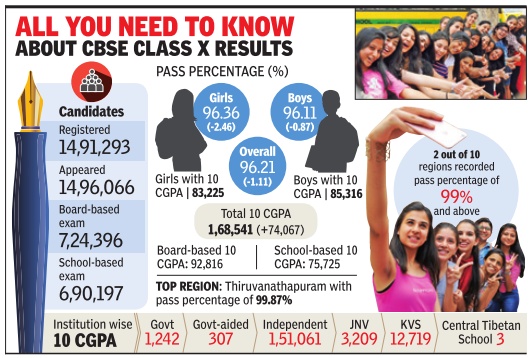
Manash Gohain
The capital had little to cheer about after the CBSE Class X results were declared on Saturday as it recorded the second-lowest pass percentage of 91.76% among all 10 regions. Thiruvananthapuram (99.87%) held on to the top spot. Overall, the pass percentage fell a point from 97.32% last year to 96.21%, though the number of those scoring a cumulative grade point average of 10 crossed the 1 lakh mark for the first time.
Girls outshone boys, albeit by a tiny fraction, after the latter had overtaken them last year. Among the girls, 96.36% cleared the exams compared with 96.11% of the boys. However, the boys held the edge in scoring high grades, with 85,316 of them logging a CGPA of 10 against 83,225 girls scoring the highest grade.
In fact, the number of those obtaining the highest CGPA of 10 rose 40% from that of 2015. A CGPA of 10 represents all those obtaining aggregate marks of 95% or above. For the first time, the number of students crossing the coveted mark went beyond 1lakh, with 1,68,541candidates eventually getting a CGPA of 10. With the introduction of continuous and comprehensive evaluation since 2009, the Class X board exams have become optional. This year, nearly 52% of the candidates opted for the school-based exam. This also means that students wanting their answer scripts to be verified would have to apply separately according to the exam they sat for. According to K K Choudhury , controller of examination, CBSE, students who took the school-based exam would have to apply for verification of grades at their respective schools. For those who took the board-based exam, applications are to be made online within seven days from the declaration of results.
Interestingly, students with a CGPA of 10 outnumbered those getting any other grade. While last year, 7.1% of the candidates had got to a CGPA figure of 10, the number went up to to 11.91% this year. Candidates from private school continued to lead the pack of top scorers with 89.62% of CGPA 10 scorers, a marginal improvement over last year's 89%.
Regionwise, Thiruvanan thapuram again led at the top with a pass percentage of 99.87%. Chennai is the only other region with 99% and above pass percentage among the 10 regions.
The number of attempts permitted for the improvement of grades in Class X has been reduced to one from five since 2013. Candidates can appear for the improvement exam in July .
Of a total of 3,510 diabled candidates, 3,335 qualified with a pass percentage of 95.18%. The server was down for nearly 40 minutes as soon as the results were released.
6 compulsory subjects: 2017-18
6 papers mandatory for CBSE Class X exam in vocational stream, March 10, 2017: The Times of India
HIGHLIGHTS
The CBSE has remodelled its assessment scheme for Class X Board examination.
From the 2017-18 academic year, it will be compulsory to study a vocational subject for students.
A candidate will have to score 33% marks in both board exam and practical exam to pass the subject.
NEW DELHI: Students appearing for Class X board exams in vocational stream will have to study six subjects instead of five with the CBSE remodelling its assessment scheme. Class X students have to presently study five subjects — two languages, social science, mathematics and science.
Students also have a choice of studying a vocational subject as an "additional" course.
However, from the 2017-18 academic year, it will be compulsory to study a vocational subject for students opting for the particular stream. The Central Board of Secondary Education (CBSE) has remodelled its assessment scheme for Class X Board examination for schools offering vocational subject as compulsory subject under the National Skills Qualifications Framework (NSQF).
"If a candidate fails to pass in any one of the three elective subjects -- science, social science, mathematics, then it will be replaced by the vocational subject (offered as sixth additional subject)," a CBSE circular said.
"The board exam result will be computed accordingly. However, if a candidate desires to reappear for the failed subject they can appear in the compartment examination," it added.
Students will have 13 options to choose from for the sixth subject -- Dynamics of Retailing, Information Technology, Security, Automobile Technology, Introduction to Financial Market, Introduction to Tourism, Beauty and Wellness, Basic Agriculture, Food Production, Front Office Operations, Banking and Insurance, Marketing and Sales, and Health Care Services.
According to the circular, the maximum marks will be 100. Out of the total 100 marks, the board exam will be of 50 marks, and 50 marks are allocated to internal assessment/practical examination.
A candidate will have to score 33 per cent marks in both board exam and practical exam to pass the subject. In another major decision, the CBSE has decided to do away with seven Academic Electives and 34 vocational subjects for Class XII because of low enrolment numbers.
Boards again from March 2018
The Times of India, Dec 21 2016
CBSE Std X board exam will be back from March 2018
The governing body of the Central Board of Secondary Education (CBSE), the highest-decision making body of the board, approved the restoration of the Class X board examinations, paving the way for the return of the public exam after seven years. Class X students in the coming academic year will take the board exam in March 2018.Final marks will give 80% weightage to the exam and 20% to internal assessment.
Since 2011, after the introduction of continuous and comprehensive evaluation (CCE) in 2009, the CBSE made the Class X board exam optional, which meant students studying in senior secondary schools had the option to sit for the school-based exams.
The board conducted a survey among various stakeholders and the majority were in favour of the Class X board exams. Thereafter, the HRD ministry announced the rollback of the optional scheme of the present Class X exam system. “It was a unanimous deci sion of the members of the governing board. The matter was discussed threadbare and in principle it was decided to restore the exams scheme of the pre-CCE period. A circular to the effect on details about the examination, which will commence from 2018, will be shared with schools soon,“ said R K Chaturvedi, CBSE chairperson.
He confirmed that 20% weightage will be given to internal assessment by the schools. “Members welcomed the decision,“ said Jyoti Arora, member of the board's GB and principal of Mount Abu Public School.
The 2016-17 batch of Class X students will continue to follow the existing format where both school-based and board-based options will be open.
Results, 2018
Class X results
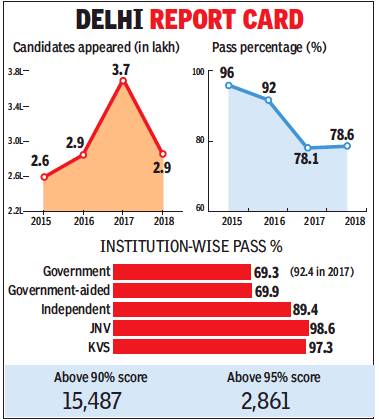
From: Manash Pratim Gohain & Krittika Sharma, Gurgaon boy jt topper in CBSE Class X, 15 of Top 25 from NCR, May 30, 2018: The Times of India
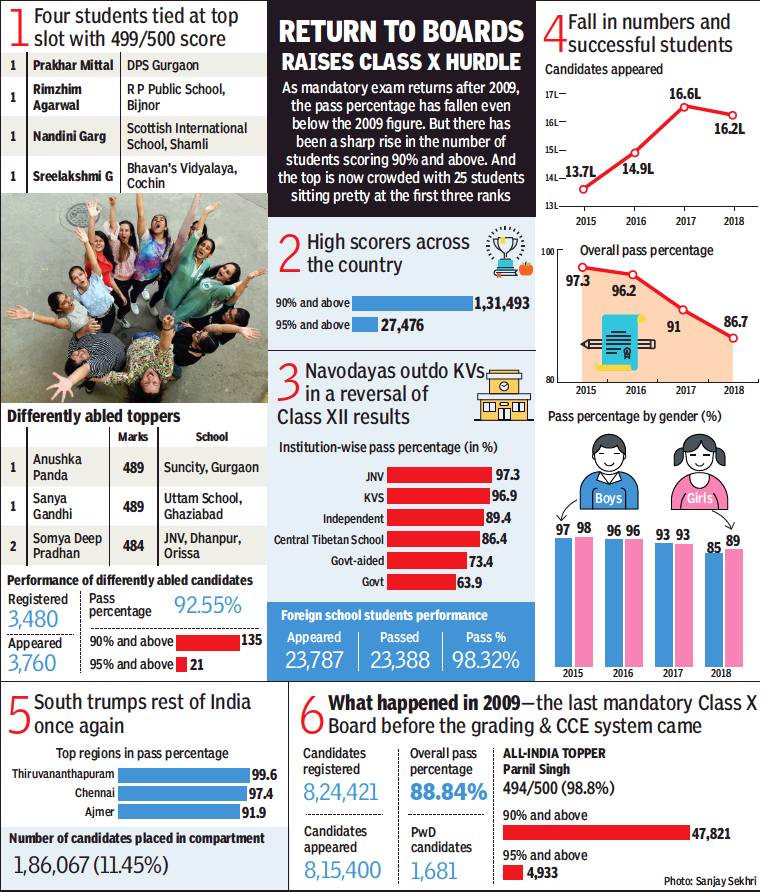
From: May 30, 2018: The Times of India
Pass Percentage Drops, Rise In High-Scorers
Pass percentages for the Class X exams have been falling since 2015 and the return of the compulsory board exam after eight years
has done nothing to arrest the trend. From 91% last year for the combined board and school-based exams, it has slipped to 86.7% this year.
The fall is precipitous compared with the pass percentage of 97.3% in 2015 and 96.2% the following year. The good news, however, is the spike in the number of high scorers and toppers this year.
The top rank was shared by four students, all scoring 499 out of 500 — missing the perfect score by a single mark, as in the CBSE Class XII boards. Around 8% of all students — 1.3 lakh — scored 90% and above. Over 27,000 had scores of 95% and more.
Although no Delhi student figures among the top 25 students with scores of 497 to 499, 15 of them are from NCR. Nine of them are small-town success stories, led by Rimjhim Agarwal from Bijnor and Nandini Garg from Shamli who shared the top spot with Prakhar Mittal of Gurgaon and Sreelakshmi G of Kochi.
Seven scored 498 out of 500 to occupy the second spot, and 14 notched up 497 to come third. Some of these students are from places like Durg, Hapur, Almora and Bilaspur.
The board exams had been made optional from 2010, primarily on the initiative of then HRD minister Kapil Sibal.
Over 1.3 lakh students score 90% or above
The purpose of this radical move was to reduce stress and let children enjoy their childhood. That year, CBSE introduced a grading system along with Continuous and Comprehensive Evaluation (CCE). This was aimed at addressing a child’s holistic development and assessing her performance through tests and grades throughout the year. The outcome of this reduced pressure seemed to be positive with the pass percentage staying above 90%.
CCE was, however, discontinued last year with the decision being taken to reintroduce the board exams. This was in response to feedback from states and representative organisations of parents and teachers that doing away with the exam along with the no-detention policy was affecting academic standards. The board exam was seen by those arguing for its reintroduction as a means of preparing students for the more important schoolleaving Class XII test.
The number of students who have scored above 90% this year across India is 1,31,493. In 2009, the number of students who had scored above 90% was significantly less — just 5.8% of the total examinees.
Delhi’s picture is not all that rosy with the pass percentage being 78.6% this year, dipping gradually over the past three years. It was 96% in 2015 and had slid to 78.1% last year from 91.8% in 2016. Among regions, Thiruvananthapuram has the best result with a pass percentage of 99.6%, followed by Chennai at 97.4% and Ajmer at 91.9%.
Overall, boys trailed girls by 3.3 percentage points. Their pass percentage is 85.3% as against 88.7% for girls.
The differently-abled students have proved their spirit and mettle with 92.5% of them passing. The number of such students who have scored above 90% is 135, comprising 3% of the total in this category. The first rankers here are from NCR — Anushka Panda from Suncity School in Gurgaon and Sanya Gandhi from Uttam School in Ghaziabad, both with a score of 489 out of 500. Somya Deep Pradhan of Jawahar Navodaya Vidyalaya, Dhanpur (Orissa), has taken the second position with 484.
Among government schools, the Jawahar Navodaya Vidyalayas have maintained their pole position for more than a decade with a pass percentage of 97.31% this year, followed by 95.96% of the students of Kendriya Vidyalayas. Private and government schools across India have fallen behind them.
JNVs better than KVs
JNV schools lead the pack, KVs shine too, May 30, 2018: The Times of India
Despite a 2.63-point dip in pass percentage, Jawahar Navodaya Vidyalayas continued to lead the CBSE board results. While the overall pass percentage dropped below the 90% mark for all institutions, JNVs and KVs had a pass percentage of 95% and above.
Among Kendriya Vidyalayas, of the 91,280 students, 87,597 (95.96%) passed with 1,357 of them scoring 95% or above. A total of 6,692 KV students scored 90% or above.
Srishti Porwal, of Kendriya Vidyalaya, AFS Begumpet Hyderabad, Zainub Iqubal of KV No. 1 AF, Pathankot Punjab and Alisha Uvais of Kendriya Vidyalaya Moradabad were joint toppers. All of them scored 494 out of 500. In all, there are 24 Kendriya Vidyalayas students who have scored 98.4% or above.
Jawahar Navodaya Vidyalayas recorded a pass percentage of 97.31 — down from 99.78 in 2017. In all, 38,536 Jawahar Navodaya Vidyalayas students appeared for the exam of which 37,437 passed. A total of 85.42% students who passed scored 60% or above, while 12.55% of the successful candidates scored 90% or above. A total of 1.80% candidates scored 95% or above.
Results, 2020
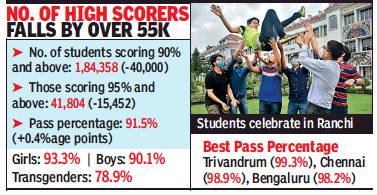
From: Shradha Chettri, Unlike Class 12, big drop in CBSE Class 10 90%+ scorers, July 16, 2020: The Times of India
No Merit List; Marginal Rise In Pass Percentage
The CBSE Class 10 results declared on Wednesday came as a surprise for many, with a falling number of high-scorers. Contrary to the Class 12 results, the number of students scoring 90% and above in Class 10 dropped to 1,84,358, a drop of over 40,000. The ones scoring 95% and above this year was 41,804, a drop of 15,452.
Even in terms of pass percentage, the increase was a marginal 0.36 percentage points. The pass percentage reached 91.5%. In 2019, the increase in pass percentage was 4.4 percentage points.
The CBSE was able to conduct the exams for Class 10 main papers before the lockdown. It was only students of northeast Delhi who had missed the papers due to the riots. For them, the marks were calculated on the basis of the average of the best three performances, and it was also one of the reasons why the board didn’t declare a merit list.
Compartment for 8% of X students
The board will only hold compartment exams when the situation is "conducive", which means there will be no second chance for the students to improve their performance. A total of 1,50,198 students have been placed in compartment, which comes to 8%, an increase from 7.9% last year.
Overall, girls have a better pass percentage at 93.3%, an increase from 92.5% in 2019. There has been no change in pass percentage for boys at 90.1%. The figure for transgender students has fallen sharply — 78.9% this year as against 94.7% in 2019.
Thiruvananthapuram region is again at the top with 99.3%, followed by Chennai and Bengaluru at 98.9% and 98.2%, respectively. Delhi region is in the second last position with a pass percentage of 85.9%. But among the other regions, Delhi has seen the highest percentage-point increase from 80.9% last year.
The performance of private schools across India has seen a drop — from 94.2% last year to 92.8% in 2020.
Jyoti Arora, principal of Mount Abu Public School, said, “I held a meeting with the teachers to explore the reasons. I was told that mathematics and science papers were tough."
But Tania Joshi, principal of The Indian School, believes, "This could be because now questions are not about rote learning. This has to be the way forward."
Alka Kapur, principal of Modern Public School, said the evaluation carried out at homes due to Covid-19 could be one factor. “When answer-sheets are checked at centres, the answers are discussed and marked," said Kapur.
Class XII
Class XII results: historical trends
CBSE is India's Central Board of Secondary Education
2014: Top scoring subjects
The Times of India, Aug 30 2015
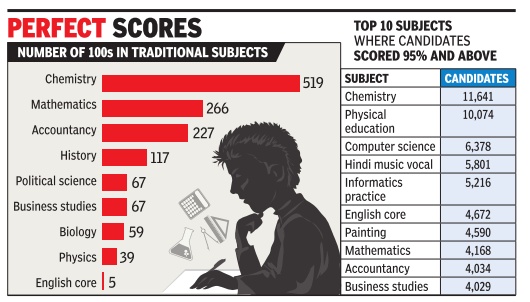
Manash Gohain Chemistry was a cakewalk for students at the Class XII Boards this year. Data on subject-wise scoring pattern from the Central Board of Secondary Education, exclusively accessed by TOI, revealed that not only were a maximum number of 100s scored in chemistry but that over 11,000 candidates also got 95% and more in the subject. The trend of high scores have continued with the number of 100s this year crossing 2,300, up from over 1,900 in 2014. The data also debunked the myth that it's easier to score in vocational electives. Mathematics, English, accountancy and business studies were among the top 10 subjects in which students scored a perfect 100 as well 95% and above. Another highlight: As many as 117 notched up a perfect score in history--a larger figure than physics, biology or business studies this year.
According to CBSE sources, the number of 100s scored among the traditional subjects--chemistry , physics, biology , mathematics, English, accountancy, business studies, history and political science--this year is 1,366. This is despite claims by schools and students that the physics and mathematics papers have been the “toughest“ in a decade. A total of 266 students scored 100 in mathematics and 39 did the same in physics.
The number of candidates scoring 95% and above in individual subjects has also been significant. Candidates have scored 95% and above in 95 subjects out of the total of 193 subjects offered by CBSE at the senior secondary level.
“In all mainstream subjects and well as in popular subjects, students seem to have performed well. Subjects like economics, Hindi core, history, political science, geography are also among the top subjects in which more than a thousand candidates have scored 95% and above. There are 10 subjects in all in which over 4,000 candidates scored 95% and above,“ said a senior official.
One of the reasons for the spike is the grace marks doled out. “Grace marks is nothing new, but this year it has been a bit on the higher side,“ said another CBSE official.
Results, 2016
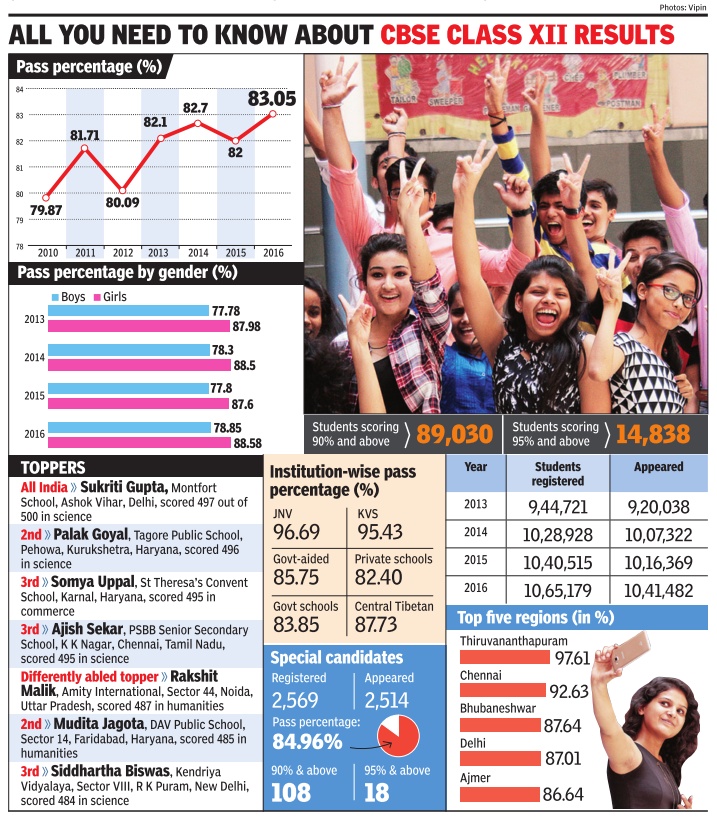
Delhi’s performance
The Times of India, May 22 2016
Delhi pass percentage better, but slips to 4th
Delhi's pass percentage, 87.01%, is better than the national average and is even an improvement over 86.13% in 2015. However, on the list of regions, the national capital has slipped to the fourth position from the third slot it got in 2015.
Governments schools have once again had a higher pass percentage than private ones--88.98%--against 86.67%. Both groups have seen slight improvement in performance compared with last year. Girls have done better than boys this year too. Besides, Kendriya Vidyalayas have outperformed others.
The national top-scorer in science is from Delhi; as is one of the top-three in the differently-abled category , but on the whole, many private schools may have seen a slight dip in average scores thanks to disappointing maths scores and wide variations in subjects such as economics and political science.However, there are still dozens with aggregate scores at or above 95%. Amity International, Mayur Vihar, has 65; Delhi Public School, Vasant Kunj has 63; DPS Dwarka, 57; Sardar Patel Vidyalaya, 35; Springdales School, Pusa Road, 27; Birla Vidya Niketan, Pushp Vihar, 25; Amity Saket, 18; Ahlcon International School, Mayur Vihar has 15; Mount Abu Public School, Rohini, has 11; and Manav Sthali School, five. There is a last number who've scored above 90% too; DPS RK Puram alone has over 500 of them.
Full marks are rarer in some subjects this year but still present in spades. The Indian School has 13 kids who've scored full marks in a subject. Springdales, Pusa Road has 11; and Ahlcon International, nine. “This is extraordinarily good,“ said Tania Joshi, principal, The Indian School, adding that there were “wide variations in performance“ in several subjects.
The CBSE hasn't released the name of the top rank holder for humanities. The humanities topper for Delhi isn't available either but Tarang Kaur of DPS RK Puram, with an aggregate of 98.2%, is a likely candidate.Ayush Srivastava of Amity International, Mayur Vihar, has come close to the top score in science with 98.6%.
It has been a decent year for economically weaker section candidates as well. Nida Khanam, daughter of an imam and supported by the alumni of the Modern School, Barakhamba Road, has scored 95.6% in the board exams. “My family has had to face a lot of crisis all through the years. Before this, I studied in a government school and always topped. But unlike that school, there was a high level of competition here,“ said Nida. She has scored a 99% in English.
KVs and JNVs continue to excel
The Times of India, May 22 2016
KVs and JNVs lead the pack with maximum passing out
The two central government-backed school chains, Kendriya Vidyalayas (KVs) and Jawahar Navodaya Vidyalayas (JNVs) continue to excel when it comes to pass percentage in the exams conducted by the Central Board of Secondary Education (CBSE).
In 2016 too they led the pack in the “best pass percentage“ category . Also, one of the toppers in the differently-abled category is from the KV system. CBSE XII results were announced.
In 2016, 70,328 students from KVs appeared for Class XII exams as against 27,413 from JNVs. JNVs recorded a pass percentage of 96.69%, a marginal drop from 96.82% recorded in 2015. Institutionwise, KVs recorded the second best pass percentage with 95.43%, up from last year's 94.72%. Siddhartha Biswas from KV , R K Puram Sector VIII scored 484 out of 500 in science.He is one of the toppers in the differently-abled category .
While the pass percentage of other institutions was hovering around 80s, the KVs and JNVs had breached the 90%mark way back in 2009. In fact, KVs and JNVs recorded 97.4% and 97.5%, respectively , in 2014, which is so far their best performance.
Caste-category wise performance
The Times of India, May 22 2016
Kshitiz Gaur
Only 1,827 ST girls took XII exams
For the first time, the CBSE declared results of the Class XII board examinations offering castebased data. Students were divided into general, SC, ST and OBC (Other Backward Caste) categories.
Educationists were surprised by this novelty. Not surprisingly, the best performers were from the general category. The data released by the board also showed that only 1,827 girls from Scheduled Tribes took the examination this year.
The results showed that 88% of students in the general category passed; 82.60% of Schedule Caste students and 82.70% of Other Backward Castes candidates secured pass marks.Only 80.50% of students of Schedule Tribes managed to pass. Some board officials, who too wished to remain anonymous, told TOI that the caste data of examinees would aid in comparing the educational performance of different social categories.
Results, 2018
Class XII results, historical trends
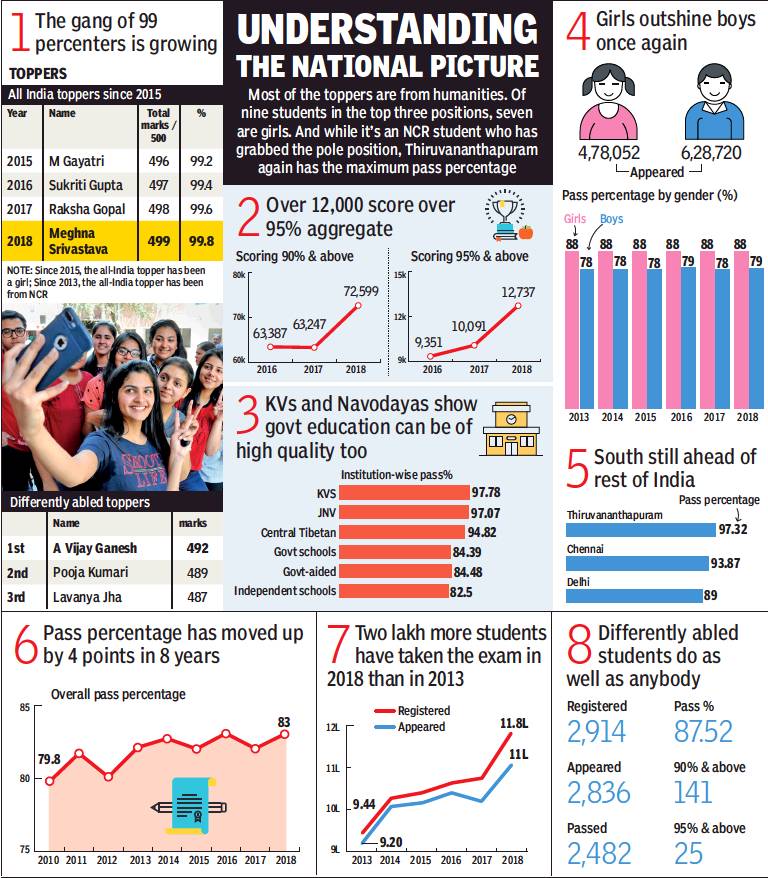
From: Manash Gohain, 499/500: Noida girl takes it another mark closer to 100%, May 27, 2018: The Times of India
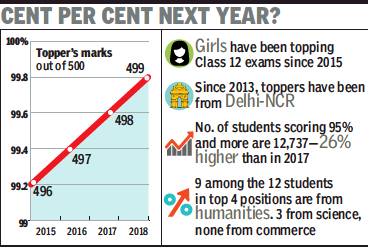
From: Manash Gohain, 499/500: Noida girl takes it another mark closer to 100%, May 27, 2018: The Times of India
73,000 Students Score Over 90%
The perfect score is now just one mark away. A Noida girl, Meghna Srivastava, has scored 499 out of 500 in CBSE’s Class XII board exams, and in the process become the all-India topper. She is a humanities student.
Last year’s topper Raksha Gopal had scored 498.
It is for the fourth consecutive year that a girl has topped the exam, and the sixth straight year when the all-India topper is from Delhi-NCR. Of the 13 students who got the top four positions, 11 are girls.
So intense is the race that 72,599 students scored 90% and above, 9,352 more than last year, and 12,737 have notched up 95% and more, up from 10,091. This will, of course, make admissions to Delhi University colleges tougher, with cutoffs likely to record a new high.
Nine of the 12 students who got the top four ranks are from humanities. The other three are from science.
Humanities and girls take the honours
Delhi’s Pvt Schools Lag Behind, And City In 3rd Place Behind Thiruvananthapuram, Chennai
Meghna scored a perfect 100 in four subjects – history, geography, psychology and economics. She scored 99 in English core. The girl who got the all-India second rank — Anoushka Chandra, also from Delhi-NCR — scored just one mark less than Meghna in English core. She too got a perfect 100 in history, political science, economics and psychology.
“I took humanities because I am interested in it and enjoyed studying social science. And if you pursue the subject of your interest, you will do well. There is no secret mantra; it’s just hard work. It’s not about science or humanities, it’s all about one’s interest. However, I am happy that the stereotype of humanities students not scoring has been broken,” said Meghna.
The overall pass percentage has, meanwhile, increased by nearly 1 percentage point at 83.01 after a drop of 1.03 last year. Thiruvananthapuram continues to have the highest pass percentage (97.32), while Kendriya Vidyalayas (97.78) are the best among institutions. Girls (88.31) maintained a lead over boys (78.99) in pass percentage and also bagged the top positions. Even among the top three performers in the differently-abled categories, two are girls.
There are, according to CBSE, seven all-India third rank holders who scored 497 out of 500. They include Chahat Boghraj of Jaipur, Astha Bamba of Ludhiana, Tanuja Kapri of Haridwar, Supriya Kaushik of Noida, Nakul Gupta of Ghaziabad and Ananya Singh of Meerut.
The differently-abled are not far behind in this pursuit of excellence. A Vijay Ganesh of Palghat Lion School, Palakkad, Kerala, with a score of 492 marks, is the topper in this category. The second and third ranks are held by Pooja Kumari (489) of Model School for Visually Handicapped, Dehradun, and Lavanya Jha
(487) of Delhi Public School, R K Puram, respectively.
Institution-wise, the KVs and Jawahar Lal Nehru Vidyalayas continue to lead the pack with 97.78 and 97.07 pass percentage, respectively, Central Tibetan Schools secured 94.82%. Rest of the institutions could not cross the 85% mark, the worst performers being the private schools with 82.5 pass percentage.
The number of students in foreign schools and their pass percentage also increased significantly this year. While the total registered candidates increased to 15,771 from 14,818 in 2017, the pass percentage increased from 92.02 in 2017 to 94.94 in 2018.
Among regions, Chennai follows Thiruvananthapuram in the second place with 93.87 pass percentage. Delhi is in the third place with 89 pass percentage. The worst performing regions are the east, led by Guwahati in the 10th position with 69.06 pass percentage with Patna next (70.54).
The pass percentage of students of Delhi government schools has increased by 2.37, touching 90.64, even as private schools of the city lagged behind at 88.35.
This year, 110 cases of unfair means were reported with 32 from Guwahati and 10 from Delhi. In all, 1,02,186 candidates have been placed in compartment which is 9.78% of the total candidates who appeared in the exams.
KVs lead JNVs, best performance in 20 years
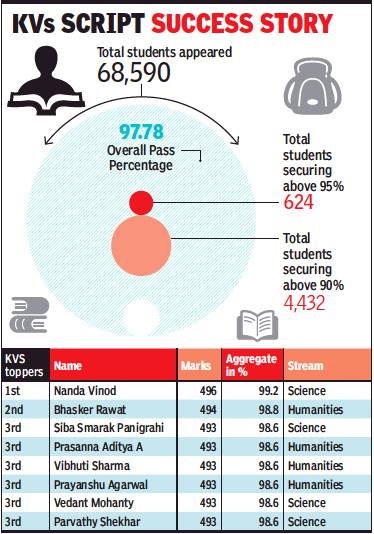
From: Manash Gohain, KVs take lead over JNVs with their best performance in 20 yrs, May 27, 2018: The Times of India
Kendriya Vidyalayas (KV) have finally bested Jawahar Navodaya Vidyalayas (JNV) in their over a decade long rivalry to become the institution to record the best pass percentage in the Class XII exams under the Central Board of Secondary Education. On top of that, the KVs were also able to record their highest ever pass percentage in the exams. Nanda Vinod of KV, District Hospital, Kannur, who topped the institution, is also the all-India joint fourth ranker.
The 97.8% pass percentage of the KVs was the highest among the institutional performances, followed by JNVs with 97.1%. This was for the first time the former topped the list. The two central government-backed school chains continue to remain the best as far as performance among institutions is concerned.
While the pass percentage of other institutions hovers in the 80s, KVs and JNVs were able to breach the 90% mark back in 2009. The KVs this year improved its pass percentage by 1.9% from 95.7% in 2017.
According to Santosh K Mall, commissioner, Kendriya Vidyalaya Sangathan, “KV students have done well in Class XII, and the institution is 0.7% ahead of JNVs for the first time. This is also the best KV result in the past 20 years as per records available and in all probability the highest of all time. We are in the process of analysing the quality dimensions of the results now.”
Vinod, a science student, obtained 496 out of 500 marks for an aggregate of 99.2%. The second KVS topper is Bhasker Rawat of KV, ONGC, Dehradun, who got 494 for an aggregate of 98.8%.
KVS officials said that preparation for improving the Class XII performance began in 2016 with a massive reshuffling of principals in the school chain. KVS also implemented a number of initiatives, among them putting in place an academic loss compensation programme for students going from the school for sports/ cultural or scientific events, monitoring and supervision of schools on specific parameters through well-devised mathematical supervision tools, conducting of special coaching and remedial, need-based classes during autumn and winter breaks, preparation and supply of centralised quality study material at headquarters with a question bank and practice papers created by subject experts from KVS, continuous interaction with parents of the principal and teachers and teachers visiting homes of children who needed support.
According to U N Khaware, additional commissioner, academics, KVS, the success was also due to the “Vidyalaya Plan”, in which the principals are empowered to devise their own plans for their school. The plan also makes the principal and the teachers accountable for its implementation. “Also, the linking of assessments of the schools with the Vidyalaya Plan and its implementation worked for the betterment of all KVs,” Khaware said.
NATIONAL TOPPERS, 2018
May 27, 2018: The Times of India
Meghna Srivastava Step By Step School, Sector 132, Noida 99.8%
When Meghna Srivastava isn’t studying, she is reading non-fiction or watching movies on Netflix. Preparing now to undertake a degree course in psychology from the University of British Columbia in Canada, she scored 100s in history, geography, psychology and economics and missed one in English by a single mark. Her percentage of 99.8% is the highest in the country. “One just has to work hard throughout the year,” the topper said. Her father, Gautam Srivastava, associate professor at Manav Rachna University, added, “Her diligence, planning and consistency propelled her to the top.”
Anoushka Chandra Seth Anandram Jaipuria School, Vasundhara, Ghaziabad 99.6%
Daughter of a defence ministry official, Anoushka Chandra followed the routine of waking up and studying for long hours at a stretch for two years. She scored perfect 100s in history, political science, economics and psychology and 98 in English gave her a cumulative 99.6%, enough to rank second in the country in humanities. “I was confident she would do well, but never that she would get the second rank,” said her mother, Ranjita Srivastava. Chandra dreams of becoming an IAS officer.
Chahat Bodraj Neerja Modi School, Jaipur 99.4%
Chahat Bodraj, resident of Mansarovar in Rajasthan, was ranked third across the country in humanities with a score of 99.4%. She is among the few students to have scored 100% in four subjects — psychology, geography, history and fine arts. She obtained 97% in English. Interested in designing and communication, Bodraj wishes to join the Pune School of Design.
“I don’t believe in studying for hours at the end. I studied throughout the year and this helped me avoid stress,” said the elated teenager.
Astha Bamba BCM Arya Model Senior Secondary School, Ludhiana 99.4%
Astha Bamba secured the all-India third rank in humanities with 99.4%. She scored perfect marks in sociology, political science and mass media, 99 in English and 98 in economics. The girl who aspires to work for the United Nations one day, said she studied to gain knowledge. “Becoming a topper was never my aim,” the 17-year-old said. “The third rank across the country is bonus because I never had the thought in my mind while preparing for my exams.”
Kshitij Anand Seth Anandram Jaipuria School, Vasundhara, Ghaziabad 99.4%
Kshitij Anand was away in Ranchi to attend the last rites of his grandfather when friends started calling him about his top ranking result. “It is a mixed feeling, but scoring 100 in English has come as a real surprise,” said the son of a deputy director in the defence ministry.
With 100s in English, maths, physics and painting and 97 in chemistry, he ended up with a percentage of 99.4. What does he want to become? “An aeronautical engineer — planes and rockets excite me,” Anand replied.
Nakul Gupta School: DPS, Rajnagar, Ghaziabad 99.4%
Nakul Gupta, who scored 99.4% to be at the third all-India spot in humanities, wants to join the Indian Foreign Service. The son of the businessman takes a huge interest in politics and watches news on TV for hours. An avid reader of non-fiction, he cycles every day to keep himself fit. “I took it easy. I did not feel too pressured, just continued regularly with daily studies,” said the youngster.
Ananya Singh Meerut Public Girls’ School, Shastri Nagar, Meerut 99.4%
Ananya Singh scored a 100 each in geography, political science, history and music. With the 97 in English, these marks earned her the third slot in the country in humanities with 99.4%. She eventually wants to sit for the civil services exam after pursuing a political science degree course in Delhi University. Singh, daughter of a police inspector, said, “Social media and the mobile phone distract me. So I kept away from them.” Her mother marvelled, “Nobody in the family has ever topped in school, let alone the district.”
Tanuja Kapri Gayatri Vidyapeeth School, Hardwar, Uttarakhand 99.4%
Daughter of a government official, Tanuja Kapri is not only Uttarakhand state topper, but also the all-India third ranker in humanities. She obtained full marks in English, Hindi, geography and painting, but ‘only’ 97 in economics. The girl who dreams of a law degree from National Law University, Bengaluru, said, “The way my pre-boards examination had gone, I was hoping to get good marks. But I never imagined I will become the state topper.” Her only regret: “I was expecting better marks in economic as the paper was quite easy.”
Supriya Kaushik Cambridge School, Sector 27, Noida 99.4 %
Supriya Kaushik is a debater, an orator and a member of the student editorial board, who now wishes to study psychology at Delhi University’s Lady Shri Ram College. With perfect 100s in English, history and psychology and 99 in political science and 98 in geography, she got 99.4% in aggregate. She more than met the expectations of her father, general manager of the NTPC plant at Dadri, and her schoolteacher. Kaushik is learning French and likes books and singing.
90.6% success rate at Delhi govt schools
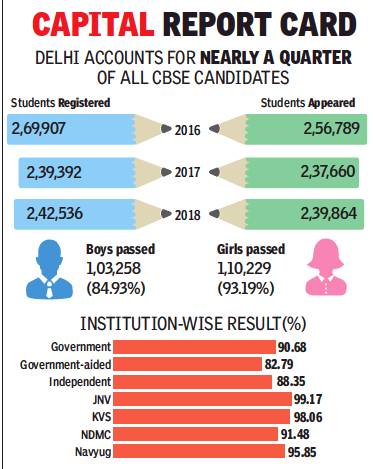
From: Krittika Sharma, With 90.6% success rate, Delhi govt schools pull off a good show, May 27, 2018: The Times of India
168 Schools Get 100% Result; Private Schools Manage Strike Rate Of 88.3%
The pass percentage of students of Delhi government schools has increased by 2.37, touching 90.64, even as private schools of the city lagged behind at 88.35.
Meanwhile, Delhi girls again outshined boys with a pass percentage of 93.19, as against the boys’ 84.93. Jawahar Navodaya Vidyalaya and Kendriya Vidyalaya continued to excel, with each recording 99.17 and 98.06 pass percentage respectively. The schools of New Delhi Municipal Council also did not stay behind, recording 93.66% result.
Deputy chief minister and education minister Manish Sisodia, while tweeting the encouraging results, congratulated his team of officials, teachers and students for having achieved a pass percentage higher than that of private schools and progressing from last year. “Congratulations to all students, teachers and parents for making us proud in CBSE Class XII results,” he tweeted.
Prince Kumar of RPVV Dwarka Sector 10 from science stream topped among all Delhi government schools with a score of 485/500 (97%). Kumar, who is the son of a DTC bus driver, also scored a 100 in maths. The commerce stream topper Prachi Prakash, scored 96.2% with a 100 in economics. Chitra Kaushik was the humanities topper with 95.6% and a 100 in history. Her father is an ASI with Delhi Police.
This year, the number of government schools getting a 100% result has also gone up from 112 to 168. Schools that have achieved 90% and above have also spiked from 554 to 638 this year. As the trend has been across the country, in Delhi government schools too, girls fared better than boys at 94.1% passing as against 85.98%.
Chief minister Arvind Kejriwal too tweeted his congratulations to the education department and the students. “This is despite all obstacles by LG, BJP ad PM. Congratulations to all students, teachers and principals (sic),” he tweeted.
The New Delhi Municipal Council schools also recorded a 4% improvement in result. The pass percentage of both NDMC schools — Navyug and NDMC — was recorded at 93.66. Navyug Schools fared better than NDMC schools, recording 95.85% result as compared to the latter’s 91.48%.
The private schools on the other hand, recorded a 4.15 increase in pass percentage, still trailing government schools at 88.35. However, schools like Amity International School-Vasundhara and DPS RK Puram led the pack with both recording toppers scores of 98.6% and 98.4%. DPS Dwarka recorded top score of 98.2% with the school aggregate at 86.08%.
